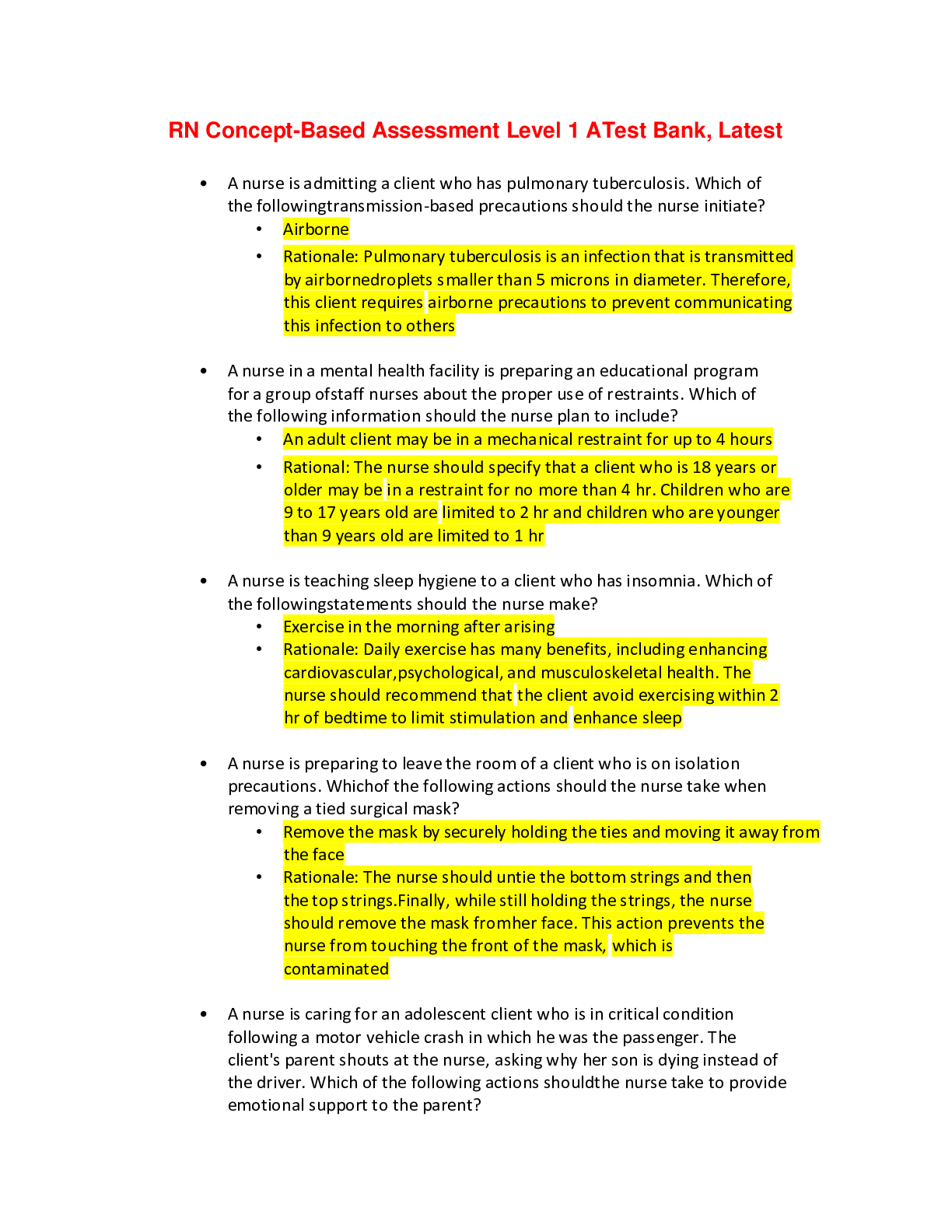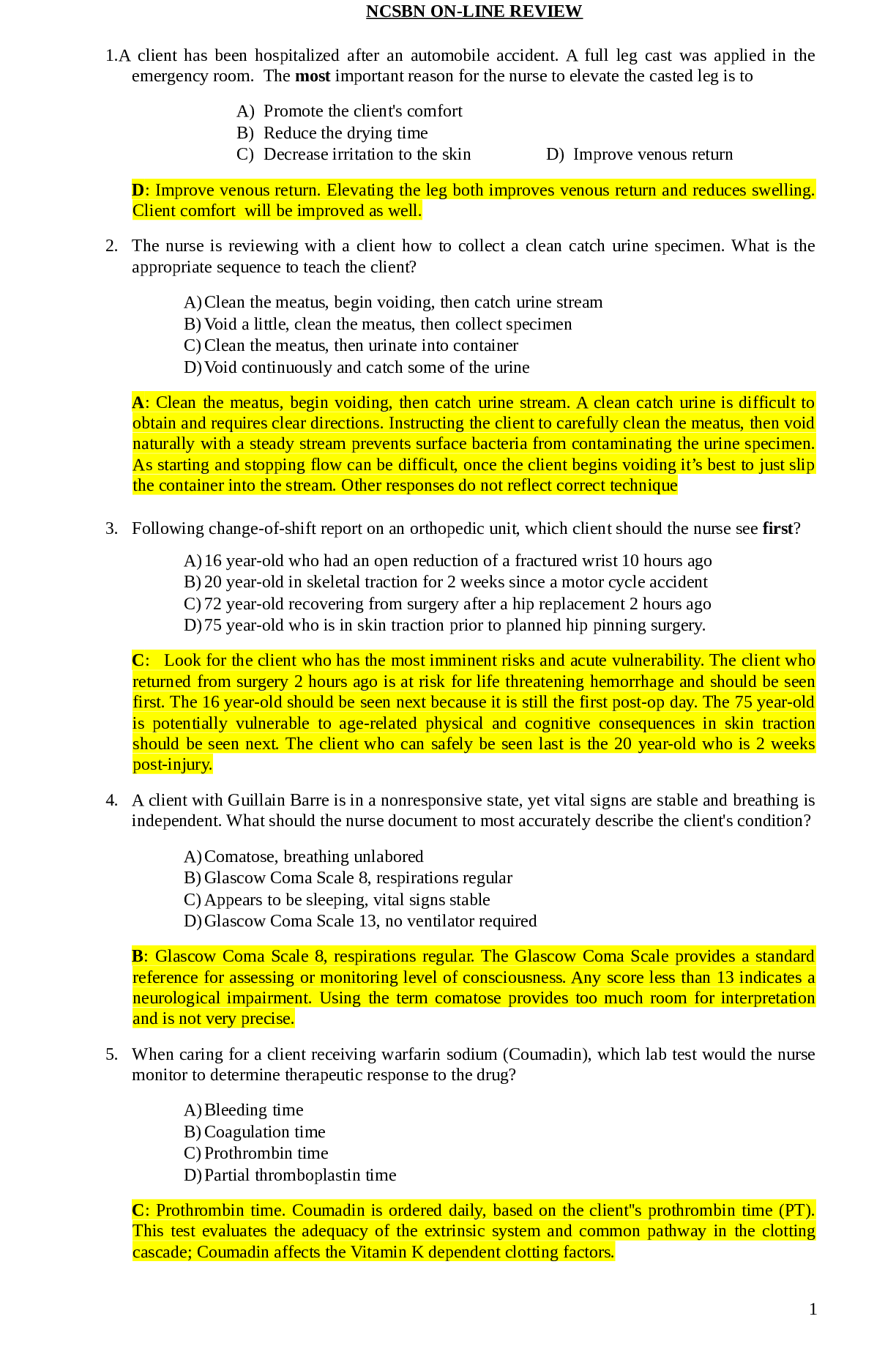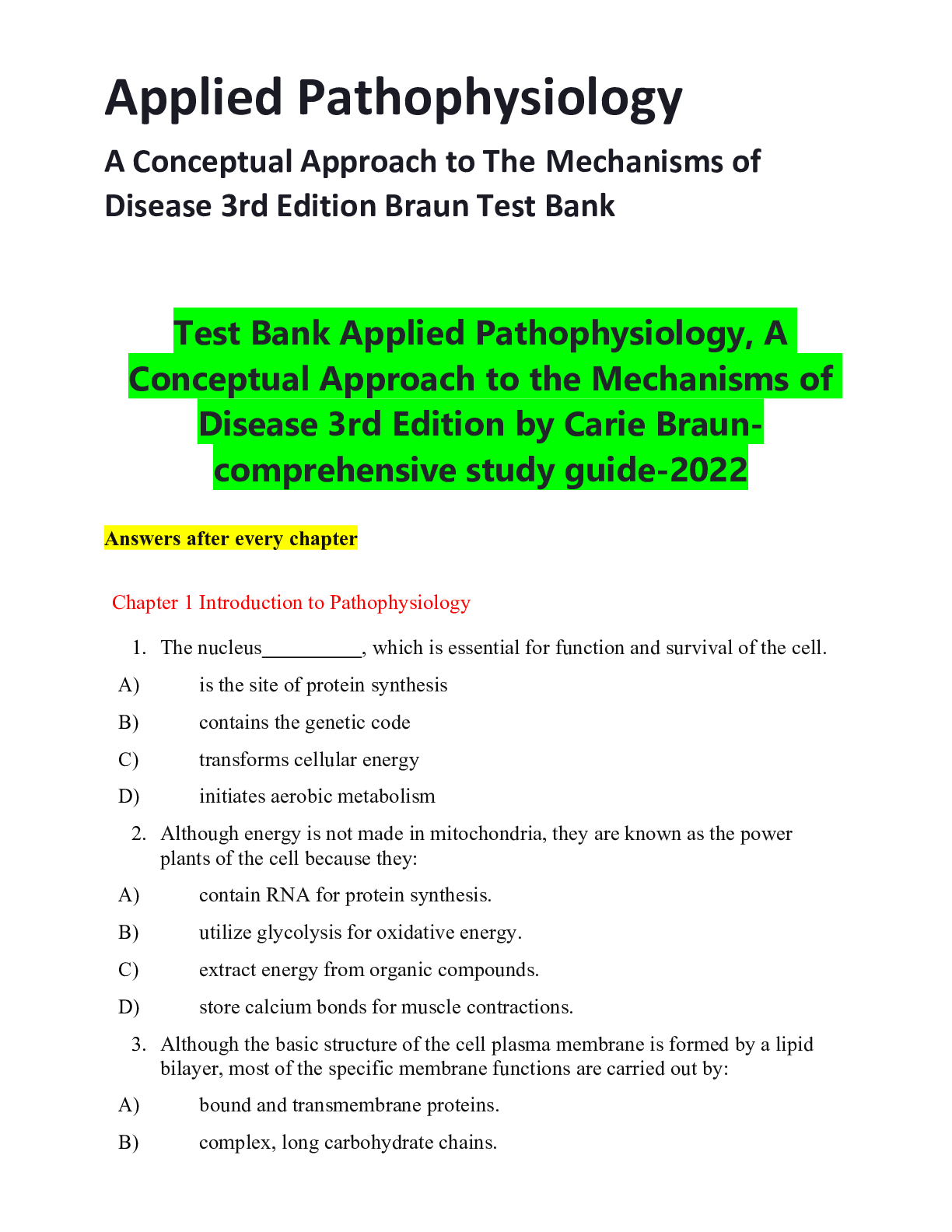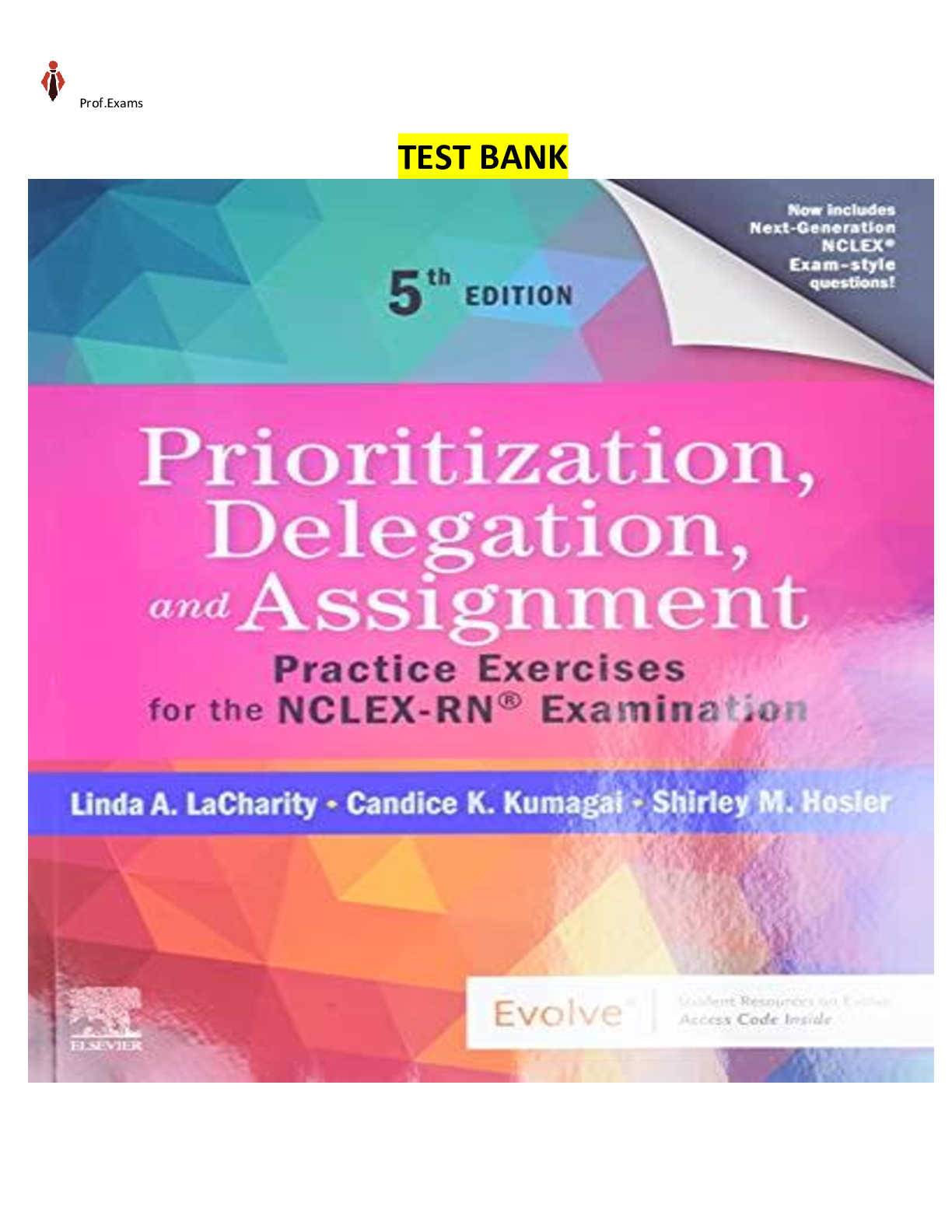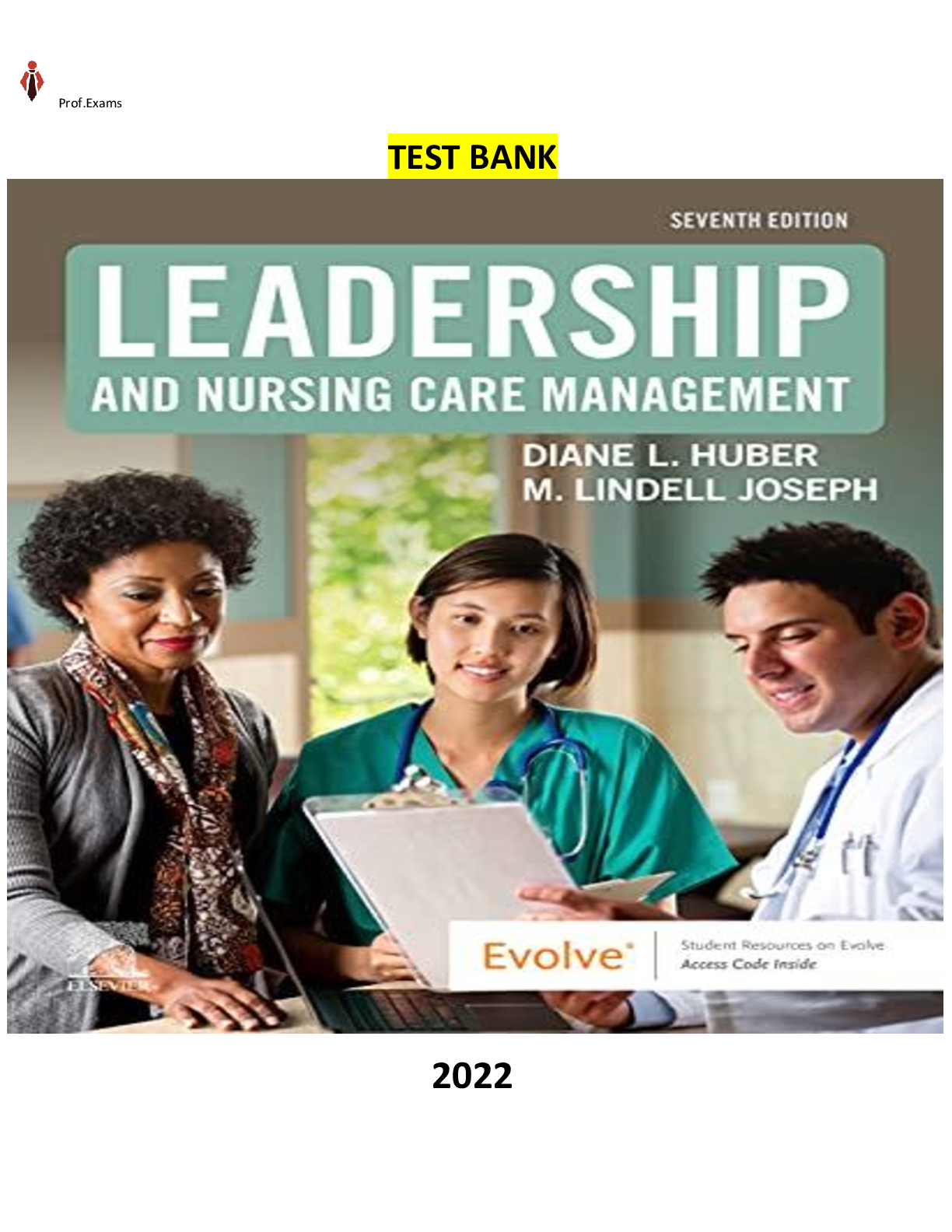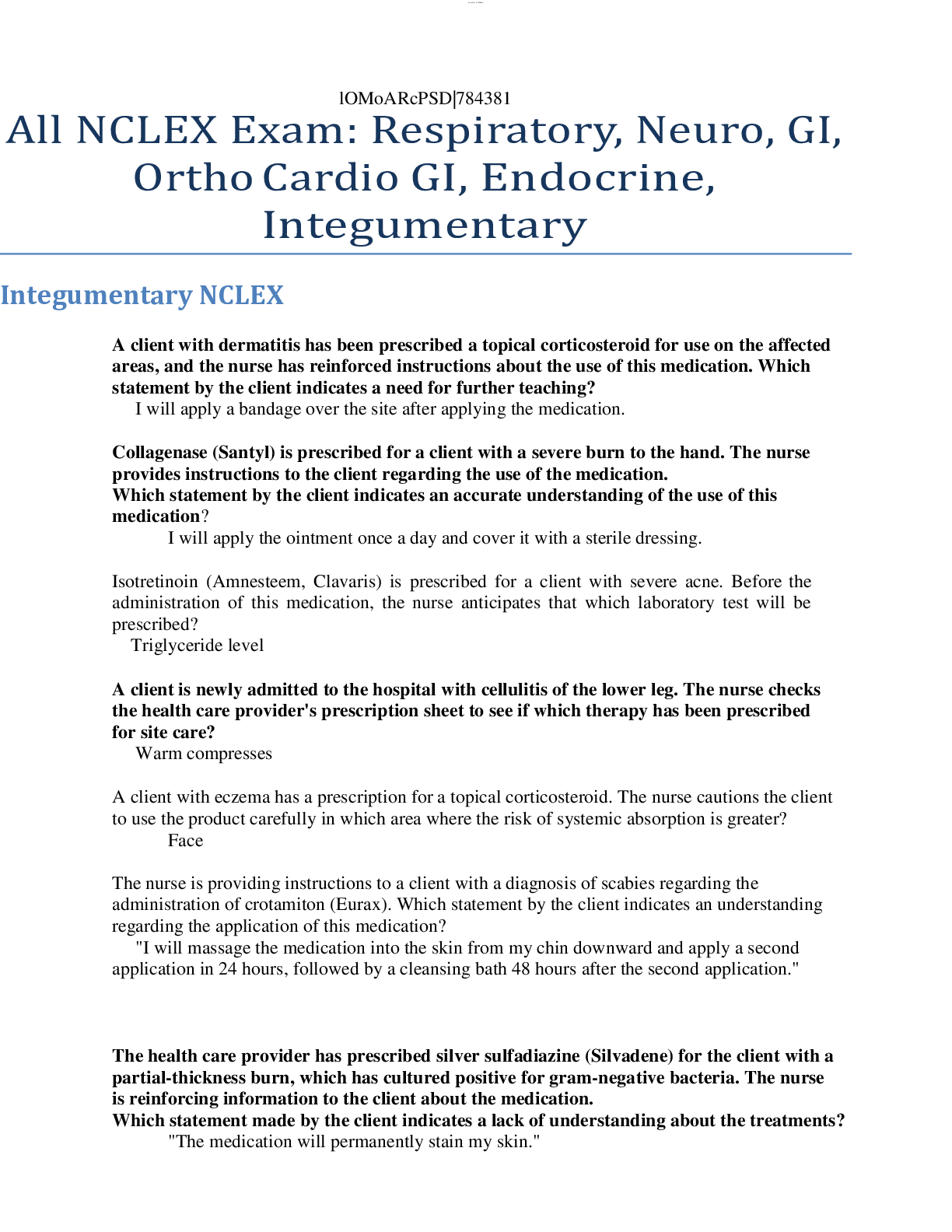*NURSING > TEST BANK > Chapter 24: NURS 340 Preparation For The Nclex Questions and Answers ,100% CORRECT (All)
Chapter 24: NURS 340 Preparation For The Nclex Questions and Answers ,100% CORRECT
Document Content and Description Below
Chapter 24: NURS 340 Preparation For The Nclex Questions and Answers Origin: Chapter 24, 1 1. The nurse is caring for a 16-year-old boy with acute myelogenous leukemia who is having chemotherapy an... d who has incomplete records for varicella zoster immunization. Which is the priority nursing diagnosis? A) Pain related to adverse effects of treatment verbalized by the child B) Nausea related to side effects of chemotherapy verbalized by the child C) Constipation related to the use of opioid analgesics for pain D) Risk for infection related to neutropenia and immunosuppression Ans: D Feedback: The priority nursing diagnosis is risk for infection related to neutropenia and immunosuppression. The incomplete records for varicella zoster immunization can cause a problem since exposure to chickenpox could cause sepsis, so the nurse should contact the oncologist for approval to administer the vaccine. Certain vaccines are not administered when the child is immunosuppressed, so timing is crucial. Diagnoses for pain and nausea are valid for this child because he is undergoing chemotherapy, but they are not a priority. Likewise, the need for constipation management would not be necessary unless opioid use begins. Origin: Chapter 24, 2 2. The nurse is caring for an 8-year-old girl who has been diagnosed with leukemia and will have a variety of tests, including a lumbar puncture, before beginning chemotherapy. What action would be the priority? A) Applying EMLA to the lumbar puncture site B) Educating the child and family about the testing procedures C) Administering promethazine as ordered for nausea D) Educating the family about chemotherapy and its side effects Ans: B Feedback: The priority would be educating the child and family about the testing procedures so they know what to expect and understand why the tests are being performed. Applying EMLA to the lumbar puncture site will be done prior to the procedure. The family will be educated about chemotherapy and its side effects prior to the therapy beginning, and promethazine or other antiemetics will be administered once chemotherapy has begun. Origin: Chapter 24, 3 3. The nurse is caring for a 13-year-old boy with acute myelogenous leukemia who is experiencing feelings of powerlessness due to the effects of chemotherapy. What intervention will best help the teen's sense of control? A) Involving the boy in decisions whenever possible B) Acknowledging the boy's feelings of anger with the disease C) Providing realistic expectations of treatments and outcomes D) Recognizing abilities that are unaffected by the disease Ans: A Feedback: Involving the boy in the decision-making process will best help his sense of control. Whether he is included in important decisions about therapy or minor decisions like menus or dress, it will give him a sense of control over his situation. Acknowledging feelings of anger, recognizing his abilities, and providing realistic expectations will reduce body image disturbance and build self-esteem. Origin: Chapter 24, 4 4. The nurse is caring for a 5-year-old girl with a disseminated medulloblastoma. What intervention would be most appropriate for this situation? A) Providing emotional support to the parents and siblings of the child B) Recommending support groups for people whose children have cancer C) Encouraging the family to cry and express feelings away from the child D) Educating the family about the disease, its treatments, and side effects Ans: C Feedback: The outcome of this highly malignant medulloblastoma is often not positive. Helping the family through anticipatory grieving by encouraging the family to cry and express feelings away from the child would be unique to this child's situation. Educating the family about the disease, its treatments, and side effects; recommending support groups; and providing emotional support to the parents and siblings would be appropriate for any child with cancer. Origin: Chapter 24, 5 5. The nurse is assessing a 3-year-old boy whose parents brought him to the clinic when they noticed that the right side of his abdomen was swollen. What finding would suggest this child has a neuroblastoma? A) The child has a maculopapular rash on his palms. B) The parents report that their son is vomiting and not eating well. C) The parents report that their son is irritable and not gaining weight. D) Auscultation reveals wheezing with diminished lung sounds. Ans: B Feedback: Along with the swollen abdomen on one side, the parents reporting that the child is vomiting and anorexic points to the possibility of a neuroblastoma. Observing a maculopapular rash on the child's palms is a sign of graft-versus-host disease. The parents reporting that the child is irritable and not gaining weight suggests a possible brain tumor as well as malabsorption problems. Auscultation revealing wheezing with diminished lung sounds would suggest other problems, not a neuroblastoma. Origin: Chapter 24, 6 6. The nurse is educating the parents of a 4-year-old boy with a Wilms tumor who is about to have chemotherapy prior to surgery. Which statement by the parents indicates that the nurse should review the instructions about preventing infection? A) "He takes his antibiotic twice a day." B) "We check his temperature orally." C) "We keep him away from crowds." D) "He must be clean and his teeth brushed." Ans: A Feedback: The parents have heard the instructions for the antibiotic administration incorrectly. The trimethoprim–sulfamethoxazole should be administered twice daily for 3 consecutive days each week to prevent Pneumocystis pneumoniae. The parents understand to avoid rectal temperatures and crowds, and to maintain his hygiene meticulously. Origin: Chapter 24, 7 7. The nurse is assessing a 13-year-old girl with a family history of kidney cancer who has come to the clinic complaining of abdominal pain, nausea, and vomiting. Which finding would the nurse identify as least likely indicative of cancer in a child? A) The child reports rectal bleeding and diarrhea. B) Observation reveals an asymmetric abdomen. C) The child experiences a broken bone without trauma. D) Palpation determines an abdominal mass. Ans: A Feedback: Rectal bleeding and diarrhea are symptoms of rectal cancer in adults and are not typical of children with cancer. The child reporting that a bone broke without any trauma, the nurse observing asymmetric swelling in the abdomen, or palpation revealing a mass in the abdomen are findings in children with cancer. Origin: Chapter 24, 8 8. The nurse is caring for a 9-year-old boy who is having chemotherapy. The nurse is developing a teaching plan for the child and family about nutrition. What instruction would the nurse be least likely to include? A) Emphasizing the intake of grains, fruits, and vegetables B) Featuring high-fiber foods if opioid analgesics are being taken C) Concentrating on consuming primarily high-calorie shakes and puddings D) Avoiding milk products if diarrhea is a problem Ans: C Feedback: Providing high-calorie shakes and puddings with diet restrictions can help with weight gain, if that is a problem. However, concentrating on high-calorie shakes and puddings is not a good strategy. It is best to provide a balanced diet emphasizing grains, fruits, and vegetables. If pain is being treated with opioid analgesics, featuring high-fiber foods is important to help relieve constipation. Avoiding milk products is a good idea if diarrhea is a problem because lactose can make diarrhea worse. Origin: Chapter 24, 9 9. The nurse is caring for a 7-year-old girl who is undergoing a stem cell transplant. What information would the nurse include in the child's postoperative plan of care? A) Assessing for petechiae, purpura, bruising, or bleeding B) Limiting blood draws to the minimum volume required C) Administering antiemetics around the clock as ordered D) Monitoring for severe diarrhea and maculopapular rash Ans: D Feedback: In the posttransplant phase, monitor closely for symptoms of graft-versus-host disease (GVHD) such as severe diarrhea and maculopapular rash progressing to redness or desquamation of the skin (especially on the palms of the hands or soles of the feet). During chemotherapy in the pretransplant phase, assess for petechiae, purpura, bruising, or bleeding to prevent hemorrhage; administer antiemetics around the clock as ordered to prevent the cycle of nausea, vomiting, and anorexia; and limit blood draws to the minimum volume required to prevent anemia. Origin: Chapter 24, 10 10. The nurse is caring for a 5-year-old boy undergoing radiation treatment for a neuroblastoma. Which nursing diagnosis would be most applicable for this child? A) Activity intolerance related to anemia and weakness from medications B) Impaired skin integrity related to desquamation from cellular destruction C) Impaired oral mucosa related to the presence of oral lesions from malnutrition D) Imbalanced nutrition, less than body requirements related to nausea and vomiting Ans: B Feedback: A nursing diagnosis for impaired skin integrity evidenced by desquamation of the radiation site would only be made for a child undergoing radiation therapy. Activity intolerance due to anemia and weakness, impaired oral mucosa evidenced by oral lesions, and malnutrition and anorexia due to nausea and vomiting are diagnoses that are common to both radiation and chemotherapy. Origin: Chapter 24, 11 11. The nurse is planning a discussion group for parents with children who have cancer. How would the nurse describe a difference between cancer in children and adults? A) Most childhood cancers affect the tissues rather than organs. B) Childhood cancers are usually localized when found. C) Unlike adult cancers, childhood cancers are less responsive to treatment. D) The majority of childhood cancers can be prevented. Ans: A Feedback: Childhood cancers usually affect the tissues, not the organs, as in adults. Metastasis often is present when the childhood cancer is diagnosed. Childhood cancers, unlike adult cancers, are very responsive to treatment. Unfortunately, little is known about cancer prevention in children. Origin: Chapter 24, 12 12.A child is receiving carboplatin as part of a chemotherapy protocol. What would be most important for the nurse to include in the child's plan of care? A) Monitoring for visual changes B) Maintaining adequate hydration C) Using prescribed eye drops to prevent conjunctivitis D) Avoiding administration with food or meals Ans: B Feedback: When fluorouracil is administered, the nurse must ensure adequate hydration. Monitoring for visual changes is appropriate when giving fludarabine. Eye drops are necessary to prevent conjunctivitis when high doses of cytarabine are administered. Oral mercaptopurine should not be given with meals or food. Origin: Chapter 24, 13 13.A child diagnosed with stage IV neuroblastoma has undergone abdominal surgery to remove the tumor. He is now receiving chemotherapy. Which nursing diagnosis would be most important? A) Risk for infection related to chemotherapy B) Impaired skin integrity related to abdominal surgery C) Grieving related to advanced disease and poor prognosis D) Imbalanced nutrition related to adverse effects of chemotherapy Ans: C Feedback: In stage IV neuroblastoma, there is metastasis to the bone, bone marrow, other organs, or distant lymph nodes. Additionally, the tumor was located in the abdomen, which is associated with a poor prognosis. Therefore, the most important diagnosis would be grieving. Although infection, skin integrity, and imbalanced nutrition may be relevant, they would not be the most important. Origin: Chapter 24, 14 14. What would be most appropriate to include in the plan of care for a child who has undergone surgery for removal of an astrocytoma? A) Elevating the foot of the bed B) Positioning the child on his unaffected side C) Raising the head of the bed at least 45 degrees D) Administering large volumes of intravenous fluids Ans: B Feedback: Postoperatively, the nurse should position the child on his unaffected side, with the head of the bed flat or at the level prescribed by the neurosurgeon. The foot of the bed is not elevated to prevent increasing intracranial pressure and contributing to bleeding. Fluids are administered carefully to avoid excess fluid intake, which would cause or worsen cerebral edema. Origin: Chapter 24, 15 15. Which test result would the nurse least likely expect to find in a child diagnosed with Wilms tumor? A) Complete blood count (CBC) within normal limits B) Urinalysis positive for blood C) Mass on kidney D) Elevated homovanillic acid (HVA) with 24-hour urine collection Ans: D Feedback: Levels of HVA and vanillylmandelic acid (VMA) will not be elevated with Wilms tumor; they are elevated with neuroblastoma. CBC, blood urea nitrogen (BUN), and creatinine usually are within normal limits. Urinalysis may reveal hematuria or leukocytes. Renal or abdominal ultrasound would reveal a mass on the kidney. Origin: Chapter 24, 16 16. The parents bring their 4-year-old son to the emergency department. The child is receiving chemotherapy for acute lymphoblastic leukemia. The parents report that the child has become lethargic and has had significant episodes of vomiting and diarrhea. Why findings would lead the nurse to suspect the child may be experiencing tumor lysis syndrome? Select all answers that apply. A) Hyperkalemia B) Hypophosphatemia C) Polyuria D) Hypocalcemia E) Hyperuricemia Ans: A, D, E Feedback: Tumor lysis syndrome is characterized by hyperuricemia, hyperkalemia, hyperphosphatemia, decreased or absent urine output, and hypocalcemia. Origin: Chapter 24, 17 17. The nurse is describing the phases of treatment to a child who was diagnosed with leukemia and his parents. How would the nurse describe the induction stage? A) Intense therapy to strengthen remission B) Rapid promotion of complete remission C) Elimination of all residual leukemic cells D) Reduction of risk for central nervous system (CNS) disease Ans: B Feedback: Induction is done to rapidly produce a complete remission. Consolidation or intensification is the stage when remission is strengthened and leukemic cell burden is reduced. Maintenance attempts to eliminate all residual leukemic cells, and CNS prophylaxis is the stage that attempts to reduce the development of CNS disease. Origin: Chapter 24, 18 18.A 14-year-old boy is diagnosed with Hodgkin disease. When palpating for enlarged lymph nodes, the nurse would expect to find which nodes as most commonly enlarged? Select all that apply. A) Cervical B) Axillary C) Supraclavicular D) Occipital E) Inguinal Ans: A, C Feedback: Enlarged lymph nodes may feel rubbery and tend to occur in clusters. Although any lymph nodes may be involved, the lymph nodes most commonly affected are in the cervical and supraclavicular areas. Origin: Chapter 24, 19 19.The nurse is preparing a presentation for a parent group about childhood cancers, focusing on brain tumors in children. What would the nurse describe as the most common type of brain tumor? A) Brain stem glioma B) Medulloblastoma C) Ependymoma D) Astrocytoma Ans: B Feedback: Of all the types of brain tumors listed, a medulloblastoma is the most common type. It is invasive, is highly malignant, and grows rapidly. Origin: Chapter 24, 20 20.A child is receiving methotrexate as part of his chemotherapy protocol. The nurse would anticipate administering which agent to counteract the toxic effects of methotrexate? A) Mesna B) Cyclosporine C) Leucovorin D) Nystatin Ans: C Feedback: Leucovorin is given as an antidote to methotrexate to reduce its toxic effects. Mesna is given when cyclophosphamide and ifosfamide are used to prevent hemorrhagic cystitis. Cyclosporine is an immunosuppressant used to treat graft-versus-host disease after hematopoietic stem cell transplant. Nystatin is used to treat mucositis or systemic fungal infection. Origin: Chapter 24, 21 21.A group of nursing students are reviewing the various drug classes used for cancer chemotherapy. The students demonstrate an understanding of these classes when they identify which agent as an example of a nitrosourea? A) Busulfan B) Thiotepa C) Cisplatin D) Carmustine Ans: D Feedback: Carmustine is an example of a nitrosourea. Busulfan, thiotepa, and cisplatin are alkylating agents. Origin: Chapter 24, 22 22. The nurse is developing a plan of care for a child who is receiving cyclophosphamide. What advice would the nurse expect to include? A) Withholding food and fluids from the child during the infusion B) Encouraging frequent voiding during and after the infusion C) Monitoring for signs of anaphylaxis during infusion D) Assessing the child for complaints of bone pain Ans: B Feedback: Cyclophosphamide may cause hemorrhagic cystitis. Therefore, the nurse needs to provide adequate hydration and have the child void frequently during and after the infusion to decrease the risk of hemorrhagic cystitis. Fluids need to be encouraged, not withheld. Monitoring for anaphylaxis would be appropriate when asparaginase or etoposide is given. Bone pain is associated with the administration of filgrastim or sargramostim. Origin: Chapter 24, 23 23. The nurse is reviewing the laboratory test results of a child who is receiving chemotherapy. To calculate the child's absolute neutrophil count, in addition to the total number of white blood cells, which results would the nurse use? Select all that apply. A) Bands B) Segs C) Eosinophils D) Basophils Ans: A, B Feedback: To calculate the absolute neutrophil count, the nurse would add together the percentage of banded and segmented neutrophils and then multiply the total number of white blood cells reported on the complete blood count by the sum. Origin: Chapter 24, 24 24.A nurse is instituting neutropenic precautions for a child. What information would the nurse most likely include? Select all that apply. A) Placing the child in a semiprivate room B) Avoiding rectal exams, suppositories, and enemas C) Placing a mask on the child when outside the room D) Encouraging an intake of raw fruits and vegetables E) Discouraging fresh flowers in the child's room Ans: B, C, E Feedback: Generally, neutropenic precautions include placing the child in a private room; avoiding rectal suppositories, enemas, and examinations; placing a mask on the child when outside the room; avoiding the intake of raw fruits and vegetables; and not permitting fresh flowers or live plants in the room. Origin: Chapter 24, 25 25.A child is scheduled to undergo radiation therapy as part of his treatment plan for newly diagnosed cancer. After teaching the child and parents about this treatment, the nurse determines that additional teaching is needed when the parents state: A) "We should not wash off the markings on his skin." B) "He can use petroleum jelly if the skin becomes reddened." C) "He needs to use a sunscreen with an SPF of 30 or more." D) "He should not apply deodorant to the treatment site." Ans: B Feedback: Aqueous creams and moisturizers may be used on the skin, but not petroleum jelly. Markings on the skin should not be removed or washed off. During and after radiation treatment, the skin will be more photosensitive so the child should use a high-SPF sunscreen of 30 or more. Deodorants and perfumed lotions should not be applied to the radiation treatment site. Origin: Chapter 24, 26 26.The nurse is conducting a physical examination of a toddler with suspected lead poisoning. Lab results indicate blood lead level 52 mcg/dL. Which action would the nurse expect to happen next? A) Repeat testing within 2 days and prepare to begin chelation therapy as ordered. B) Repeat testing within 1 week with education to decrease lead exposure. C) Confirm with repeat testing in 1 month and referral to local health department. D) Prepare to admit child to begin chelation therapy. Ans: A Feedback: The recommendation for blood lead levels of 45 to 69 mcg/dL is to confirm the level with a repeat laboratory test within 2 days and educate the parents to decreased lead exposure. She should also expect to begin chelation therapy as ordered and refer the case to the local health department for investigation of home lead reduction with referrals for support services. Repeat testing in 1 week with parent education is appropriate for lead levels between 20 and 44 mcg/dL. Repeat testing in 1 month and education would be appropriate for levels between 15 and 19 mcg/dL. Preparing to admit the child to begin chelation therapy immediately would be appropriate for lead levels greater than 70 mcg/dL. Origin: Chapter 24, 27 27.A nurse is conducting a physical examination of a 5-year-old with suspected iron- deficiency anemia. How would the nurse evaluate for changes in neurologic functioning? A) "Open your mouth so I can look inside your cheeks and lips." B) "Do you have any bruises on your feet or shins?" C) "Will you show me how you walk across the room?" D) "Let me see the palms of your hands and soles of your feet." Ans: C Feedback: Neurologic effects of iron deficiency may be demonstrated when the child's ability to sit, stand, and walk are impaired. Inspecting the mouth, looking for bruises, and checking the hands and feet provide information about signs of petechiae, purpura, or pallor. Origin: Chapter 24, 28 28. The nurse is caring for a 12-year-old boy with idiopathic thrombocytopenia. The nurse is providing discharge instructions about home care and safety recommendations to the boy and his parents. Which response indicates a need for further teaching? A) "We should avoid aspirin and drugs like ibuprofen." B) "He can resume participation in football in 2 weeks." C) "Swimming would be a great activity." D) "Our son cannot take any antihistamines." Ans: B Feedback: The nurse must emphasize to the parents that they need to prevent trauma to their son by avoiding activities that may cause injury. Participation in contact sports like football is not recommended. Aspirin, nonsteroidal anti-inflammatory drugs, and antihistamines should be avoided because they could precipitate anemia. Swimming, a noncontact sport, is an appropriate choice. Origin: Chapter 24, 29 29. The nurse is assessing a child with suspected thalassemia. What would the nurse expect to assess? A) Dactylitis B) Frontal bossing C) Presence of clubbing D) Presence of spooning Ans: B Feedback: The nurse would expect to find skeletal deformities such as frontal or maxillary bossing. Dactylitis is associated with sickle cell anemia. Clubbing and spooning are associated with chronic decreases in oxygen supply. Origin: Chapter 24, 30 30. The nurse is caring for a child recently diagnosed with glucose-6-phosphate dehydrogenase (G6PD) deficiency. The nurse is teaching the parents about triggers that may result in oxidative stress. Which response indicates a need for further teaching? A) "I doubt he will ever eat fava beans, but they could trigger hemolysis." B) "He must avoid exposure to naphthalene, an agent found in mothballs." C) "He must never take methylene blue for a urinary tract infection." D) "My son can never take penicillin for an infection." Ans: D Feedback: The nurse should emphasize that penicillin is not a known trigger that may result in oxidative stress and hemolysis. Fava beans, naphthalene, and methylene blue can trigger oxidative stress. Origin: Chapter 24, 31 31. The nurse is caring for a 13-year-old girl with von Willebrand disease. After teaching the adolescent and her parents about this disorder and care, which response by the parents indicates a need for additional teaching? A) "We need to administer Stimate prior to dental work." B) "We should be aware that she may suffer from menorrhagia." C) "We should administer desmopressin as often as needed." D) "We understand that she may have frequent nosebleeds." Ans: C Feedback: The parents need to know that desmopressin spray Stimate is used for controlling bleeding; the other brands are used for homeostasis and enuresis. Additionally, Stimate should only be used 3 days in a row as lessening of the response (tachyphylaxis) occurs with frequent use. Stimate should be used before dental work. Menorrhagia and nosebleeds may occur. Origin: Chapter 24, 32 32. The nurse is caring for a child who has been admitted for a sickle cell crisis. What would the nurse do first to provide adequate pain management? A) Administer a nonsteroidal anti-inflammatory drug (NSAID) as ordered. B) Use guided imagery and therapeutic touch. C) Administer meperidine as ordered. D) Initiate pain assessment with a standardized pain scale. Ans: D Feedback: The nurse should first initiate pain assessment with a standardized pain scale upon admission and provide frequent evaluations of pain. Administering NSAIDs or meperidine and the use of nonpharmacologic pain management techniques are all appropriate. However, the first action is to assess the child's pain to provide a baseline for future comparison. Origin: Chapter 24, 33 33. The nurse is caring for a 2-year-old boy with hemophilia. His parents are upset by the possibility that he will become infected with hepatitis or HIV from the clotting factor replacement therapy. Which response by the nurse would be most appropriate? A) "Parents commonly fear the worst; however, the factor will help your child lead a normal life." B) "There are risks with any treatment including using blood products, but these are very minor." C) "Although factor replacement is expensive, there's more financial strain from missing work if he has a bleeding episode." D) "Since dry heat treatment of the factor began in 1986, there have been no reports of virus transmission." Ans: D Feedback: The nurse needs to emphasize that since 1986, there have been no reports of virus transmission from factor infusion since the inception of heat treatment of the factor. Telling the parents that there is a minor risk does not teach. Telling the parents that factor is expensive or that it is common to worry does not teach, nor does it address their concerns. Origin: Chapter 24, 34 34. The nurse is caring for a child with thalassemia who is receiving chelation therapy at home using a battery-operated pump. After teaching the parents about this treatment, which statement by the mother indicates a need for additional teaching? A) "I can have the nurse administer the chelation therapy if I am uncomfortable." B) "I must be very careful to strictly adhere to the chelation regimen." C) "The deferoxamine binds to the iron so it can be removed from the body." D) "The medication can be administered while my child is sleeping." Ans: A Feedback: The nurse needs to emphasize to the mother that therapy must be maintained at home to continuously decrease the iron levels in the child's body. Family members need to be taught to administer deferoxamine subcutaneously with a small battery-powered infusion pump over a several-hour period each night (usually while the child is sleeping). Origin: Chapter 24, 35 35. When evaluating the hemogram of an 8-month-old infant, the nurse would identify which type of hemoglobin as being the predominant type? A) Hemoglobin A B) Hemoglobin F C) Hemoglobin A2 D) Hemoglobin S Ans: A Feedback: Three types of normal hemoglobin are present at any given time in the blood: A, F, and A2. By 6 months of age, hemoglobin A is the predominant type. Hemoglobin S is associated with sickle cell disease. Origin: Chapter 24, 36 36. The nurse is evaluating the laboratory test results of a 7-year-old child with a suspected hematologic disorder. Which finding would cause the nurse to be concerned? A) WBC: 5.6 X 103/mm3 B) RBC: 2.8 X 106/mm3 C) Hemoglobin: 11.4 mg/dL D) Hematocrit: 35% Ans: B Feedback: The RBC listed is below the normal range for a child between the ages of 6 and 16 years (4.0 to 5.2 X 106/mm3). The WBC count, hemoglobin, and hematocrit are within acceptable parameters for a child this age. Origin: Chapter 24, 37 37. When providing care to a child with aplastic anemia, which nursing diagnosis would be the priority? A) Risk for injury B) Imbalanced nutrition, less than body requirements C) Ineffective tissue perfusion D) Impaired gas exchange Ans: A Feedback: For the child with aplastic anemia, safety is of the utmost concern, with injury prevention essential to prevent hemorrhage. Nutrition, tissue perfusion, and gas exchange may or may not be associated with the child's condition. Origin: Chapter 24, 38 38. The nurse is reviewing the laboratory test results of a child diagnosed with disseminated intravascular coagulation (DIC). What would the nurse interpret as indicative of this disorder? A) Shortened prothrombin time B) Increased fibrinogen level C) Positive fibrin split products D) Increased platelets Ans: C Feedback: Laboratory test results associated with DIC include positive fibrin split products; prolonged prothrombin time, partial thromboplastin time, bleeding time, and thrombin time; decreased fibrinogen levels, platelets, clotting factors II, V, VIII, and X, and antithrombin III; and increased levels of fibrinolysin, fibrinopeptide A, and positive D- dimers. Origin: Chapter 24, 39 39.A nurse is providing care to a child with idiopathic thrombocytopenic purpura with a platelet count of 18,000/mm3. Which medication would the nurse most likely expect to be ordered? A) Folic acid B) Intravenous immune globulin C) Dimercaprol D) Deferoxamine Ans: B Feedback: Intravenous immune globulin would be used to treat idiopathic thrombocytopenic purpura. Folic acid is used to treat folic acid deficiency anemia. Dimercaprol is used to remove lead from the soft tissue and bone to allow for excretion by the kidneys. Deferoxamine is used to treat iron toxicity. Origin: Chapter 24, 40 40.The nurse is reviewing the white blood cell differential of a 4-year-old girl. Which value would lead the nurse to be concerned? A) Bands: 8% B) Segs: 28% C) Eosinophils: 10% D) Basophils: 0% Ans: C Feedback: For a 4-year-old, normally eosinophils range from 0% to 3%; therefore, a result of 10% would be abnormal and a cause for concern. Bands of 8%, segs of 28%, and basophils of 0% are normal values for this age. Origin: Chapter 24, 41 41.A child with suspected sickle cell disease is scheduled for a hemoglobin electrophoresis. When reviewing the child's history, what would the nurse identify as potentially interfering with the accuracy of the results? A) Use of iron supplementation B) Blood transfusion 1 month ago C) Lack of fasting for 12 hours D) History of recent infection Ans: B Feedback: Blood transfusion within the previous 12 weeks may alter the results of the hemoglobin electrophoresis. Iron supplements can increase serum ferritin levels. Children should fast for 12 hours before having a specimen obtained for iron levels. A history of infection might interfere with the white blood cell count results, not hemoglobin electrophoresis. Origin: Chapter 24, 42 42. The mother of a 5-year-old girl brings the child to the clinic for an evaluation. The mother tells the nurse, "She seems to be so tired and irritable lately. And she looks so pale." Further assessment reveals pale conjunctiva and oral mucous membranes. The nurse suspects iron-deficiency anemia. Which additional finding would help provide additional evidence for this suspicion? A) Spooned nails B) Negative splenomegaly C) Oxygen saturation: 99% D) Bradycardia Ans: A Feedback: Spooning or concave shape of the nails suggests iron-deficiency anemia. Other findings would include decreased oxygen saturation levels, tachycardia, and possible splenomegaly. Origin: Chapter 24, 43 43. The nurse is teaching the parents of a child diagnosed with iron-deficiency anemia about ways to increase their child's intake of iron. The parents demonstrate understanding of the teaching when they identify which foods as good choices for the child? Select all that apply. A) Tuna B) Salmon C) Tofu D) Cow's milk E) Dried fruits Ans: A, B, C, E Feedback: Foods high in iron include red meats, tuna, salmon, eggs, tofu, enriched grains, dried beans and peas, dried fruits, leafy green vegetables, and iron-fortified breakfast cereals. Origin: Chapter 24, 44 44.A child is prescribed monthly injections of vitamin B12. When developing the teaching plan for the family, the nurse would focus on which type of anemia? A) Aplastic anemia B) Pernicious anemia C) Folic acid anemia D) Sickle cell anemia Ans: B Feedback: Monthly injections of vitamin B12 are used to treat pernicious anemia. Aplastic anemia is characterized by a decrease in all blood cells necessitating a bone marrow transplant. Folic acid deficiency anemia is treated with dietary measures and possible folic acid supplementation. Sickle cell anemia is treated supportively with a focus on preventing sickling crisis, infection, and other complications. Origin: Chapter 24, 45 45.A nurse is leading a discussion with a group of new mothers about newborn nutrition and its importance for growth and development. One of the mothers asks, "Doesn't the baby get iron from me before birth?" Which response by the nurse would be most appropriate? A) "You give the baby some iron, but it is not enough to sustain him after birth." B) "Because the baby grows rapidly during the first months, he uses up what you gave him." C) "The iron you give him before birth is different from what he needs once he is born." D) "If the baby didn't use up what you gave him before birth, he excretes it soon after birth." Ans: B Feedback: In the term infant, a period of physiologic anemia occurs between the age of 2 and 6 months. This is due to the fact that the infant demonstrates rapid growth and an increase in blood volume over the first several months of life, and maternally derived iron stores are depleted by age 4 to 6 months of age. Sufficient iron intake is critical for the appropriate development of hemoglobin and RBCs. Therefore, the infant must ingest adequate quantities of iron either from breast milk or from iron-fortified formula in early infancy and other food sources in later infancy. Origin: Chapter 24, 46 46.A 5-year-old girl is diagnosed with iron-deficiency anemia and is to receive iron supplements. The child has difficulty swallowing tablets, so a liquid formulation is prescribed. After teaching the parents about administering the iron supplement, which statement indicates the need for additional teaching? A) "She needs to eat foods that are high in fiber so she doesn't get constipated." B) "We'll try to get her to drink lots of fluids throughout the day." C) "We will place the liquid in the front of her gums, just below her teeth." D) "We need to measure the liquid carefully so that we give her the correct amount." Ans: C Feedback: When giving liquid iron supplements, the liquid should be placed behind the teeth because it can stain the teeth. Iron can lead to constipation, so increased fluid and fiber intake is appropriate. The dosage needs to be measured carefully to prevent overdosing the child, leading to iron toxicity. Origin: Chapter 24, 47 47. The nurse is assessing a child with aplastic anemia. What would the nurse expect to assess? Select all that apply. A) Ecchymoses B) Tachycardia C) Guaiac-positive stool D) Epistaxis E) Severe pain F) Warm tender joints Ans: A, B, C, D Feedback: Assessment findings associated with aplastic anemia include ecchymoses, epistaxis, guaiac-positive stools, and tachycardia. Severe pain and warm tender joints are most often associated with sickle cell crisis. Origin: Chapter 24, 48 48. The nurse is developing a plan of care for a child with thalassemia. What information would the nurse expect to include? Select all that apply. A) Packed RBC transfusions B) Deferoxamine therapy C) Heparin therapy D) Opioid analgesics E) Platelet transfusions F) Intravenous immunoglobulin Ans: A, B Feedback: RBC transfusions and deferoxamine for chelation are used to treat thalassemia. Heparin therapy is used for treating DIC. Opioid analgesics would be used to treat severe pain associated with sickle cell crisis. Platelet transfusions and intravenous immunoglobulin would be used to treat idiopathic thrombocytopenia purpura. Origin: Chapter 24, 49 49.A group of students is reviewing information about glucose-6-phosphate dehydrogenase (G6PD) deficiency. The students demonstrate understanding of the material what as the cause of the disorder? A) X-linked recessive inheritance B) Deficiency in clotting factors C) An excess supply of iron D) Autosomal recessive inheritance Ans: A Feedback: G6PD deficiency is an X-linked recessive disorder that affects the functioning of the red blood cells. A deficiency in clotting factors is associated with disorders such as idiopathic thrombocytopenia purpura, DIC, or hemophilia. An excess supply of iron refers to hemosiderosis, a complication of thalassemia, an autosomal recessive disorder. [Show More]
Last updated: 10 months ago
Preview 1 out of 21 pages
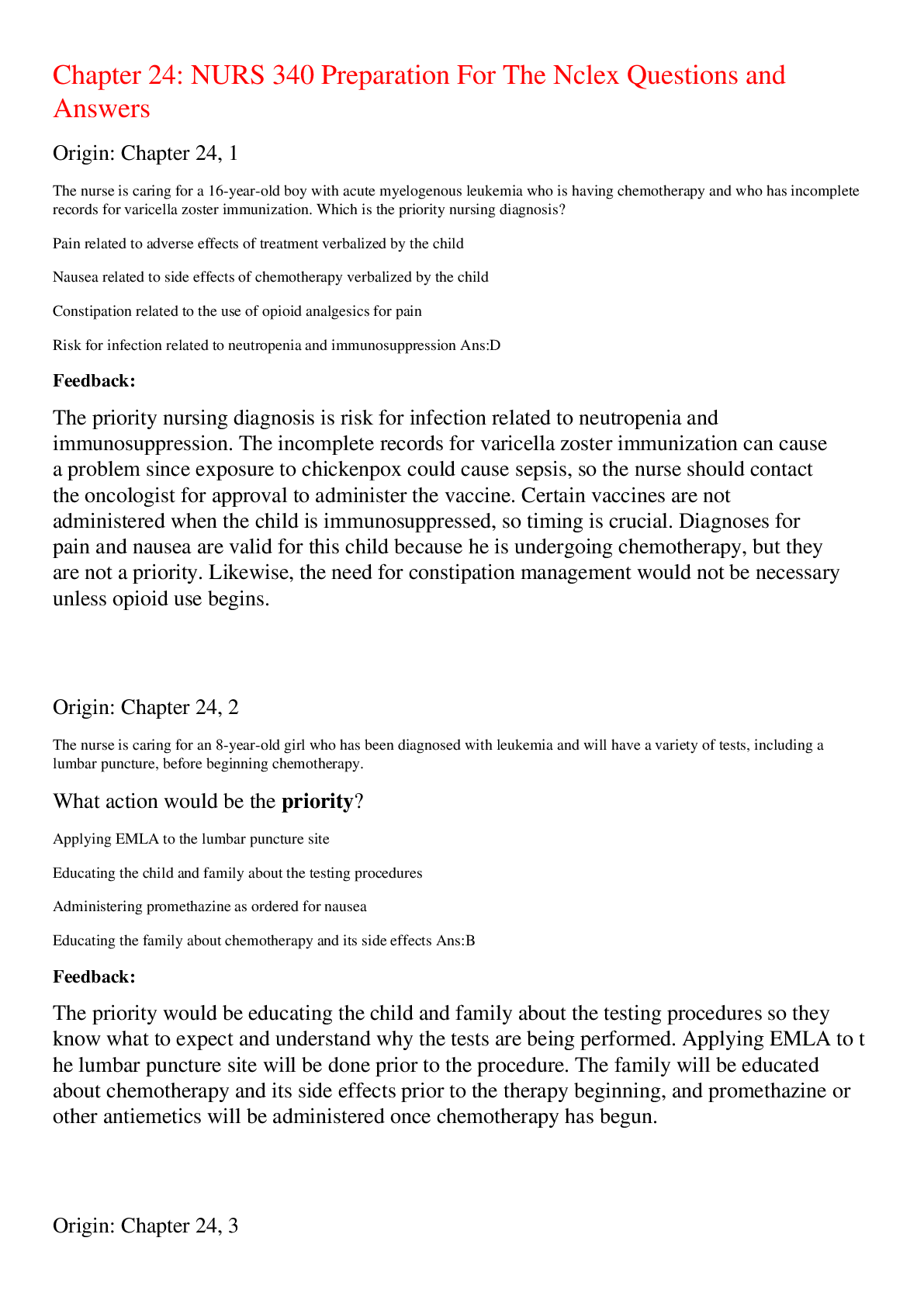
Reviews( 0 )
Document information
Connected school, study & course
About the document
Uploaded On
Mar 02, 2023
Number of pages
21
Written in
Additional information
This document has been written for:
Uploaded
Mar 02, 2023
Downloads
0
Views
77




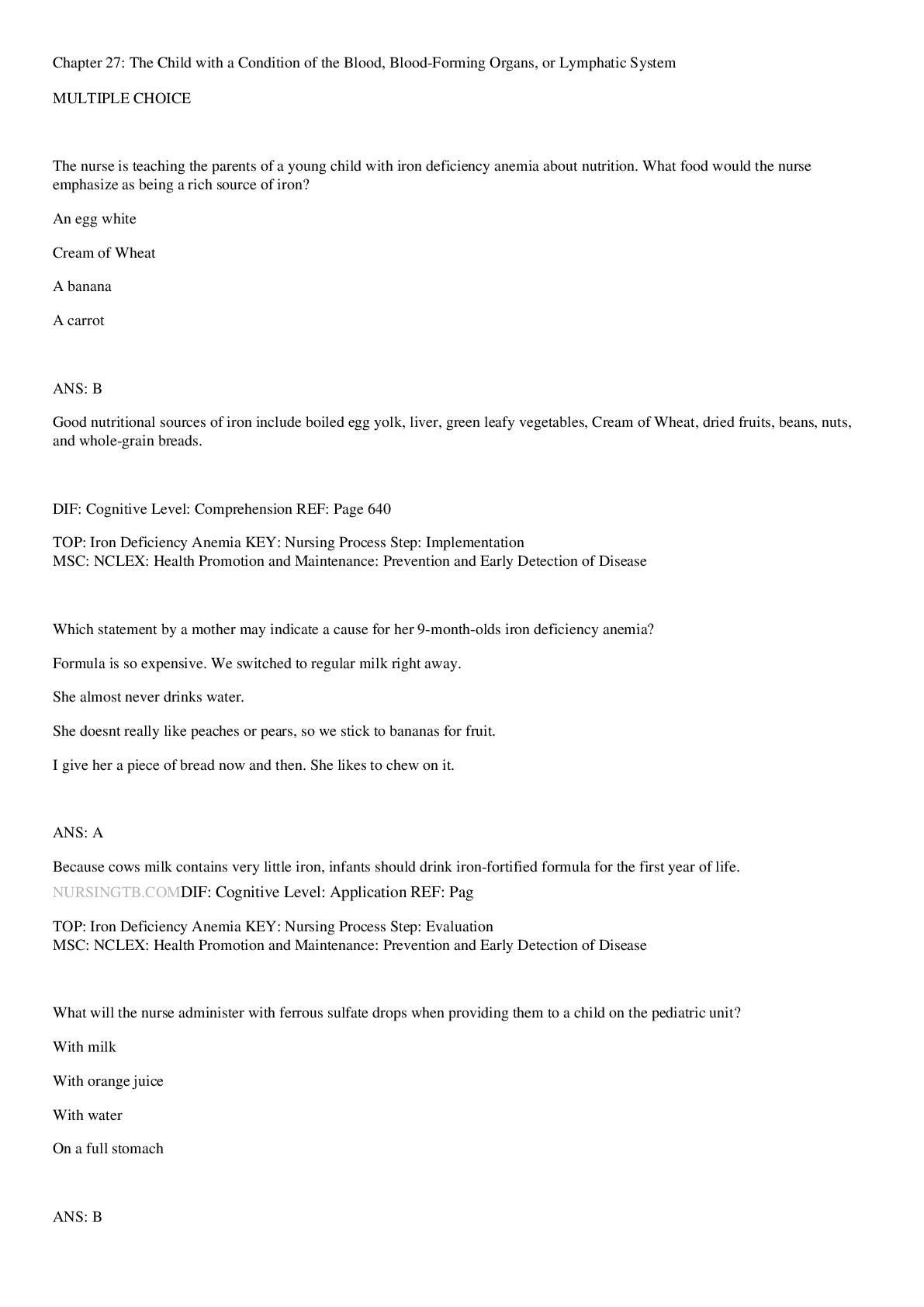



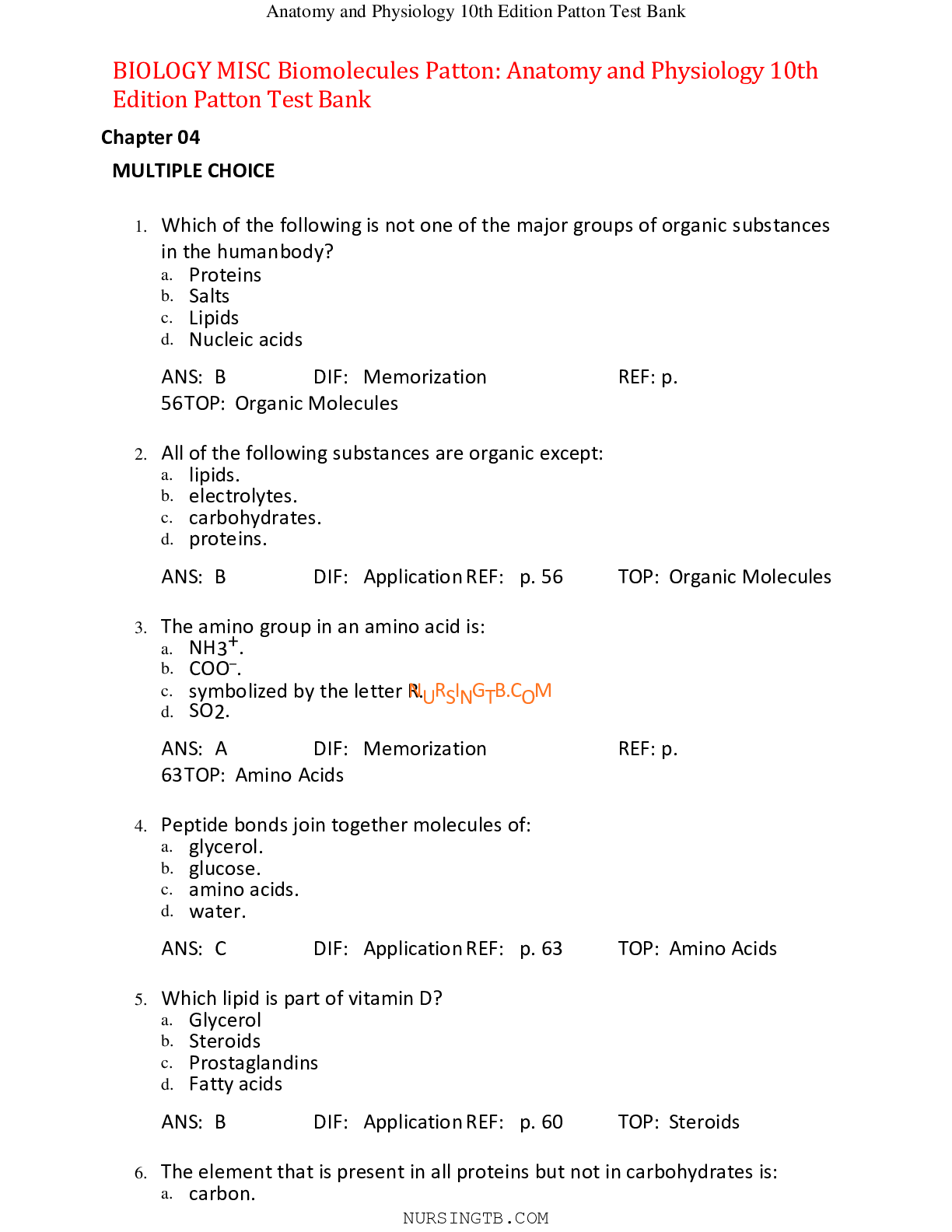
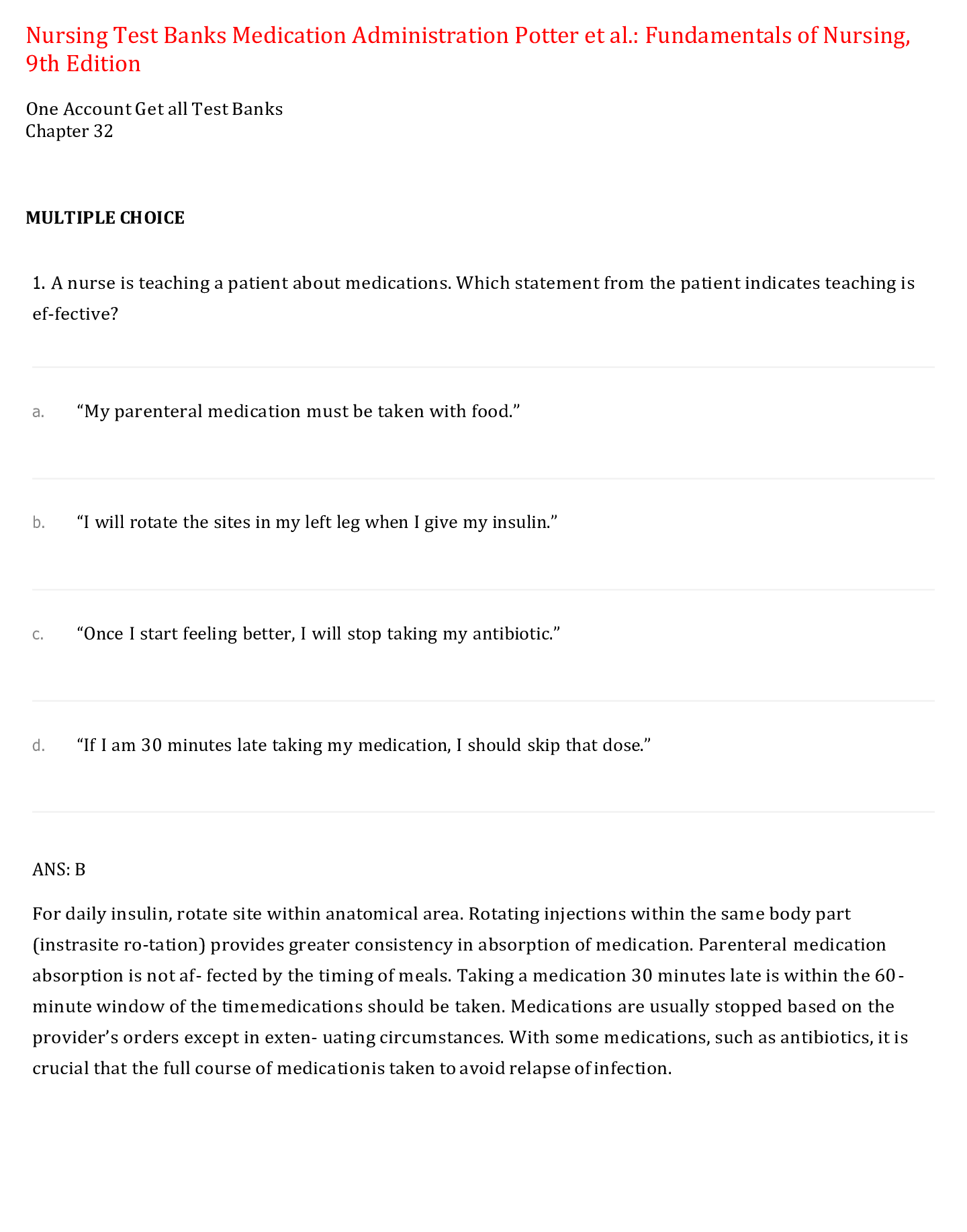

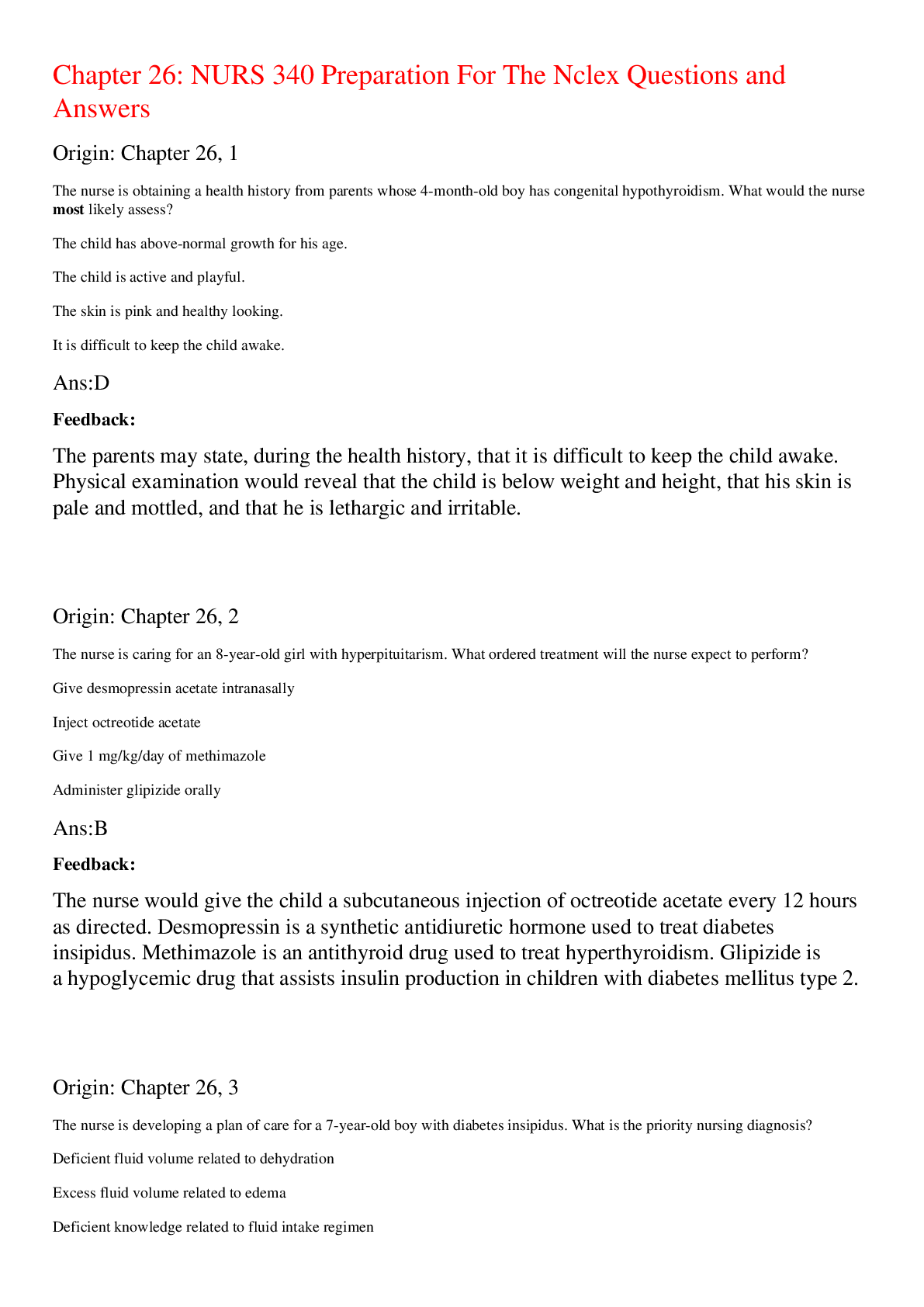
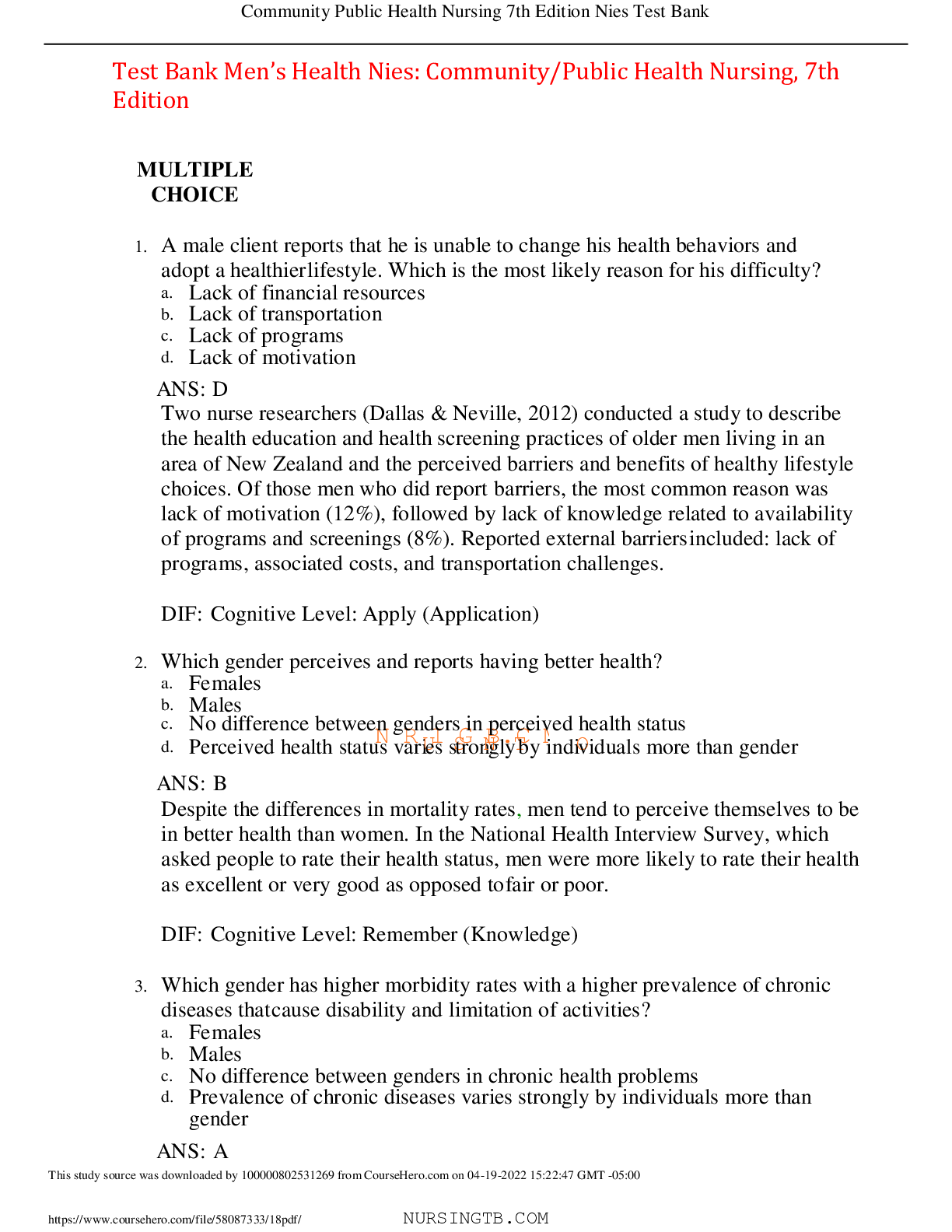
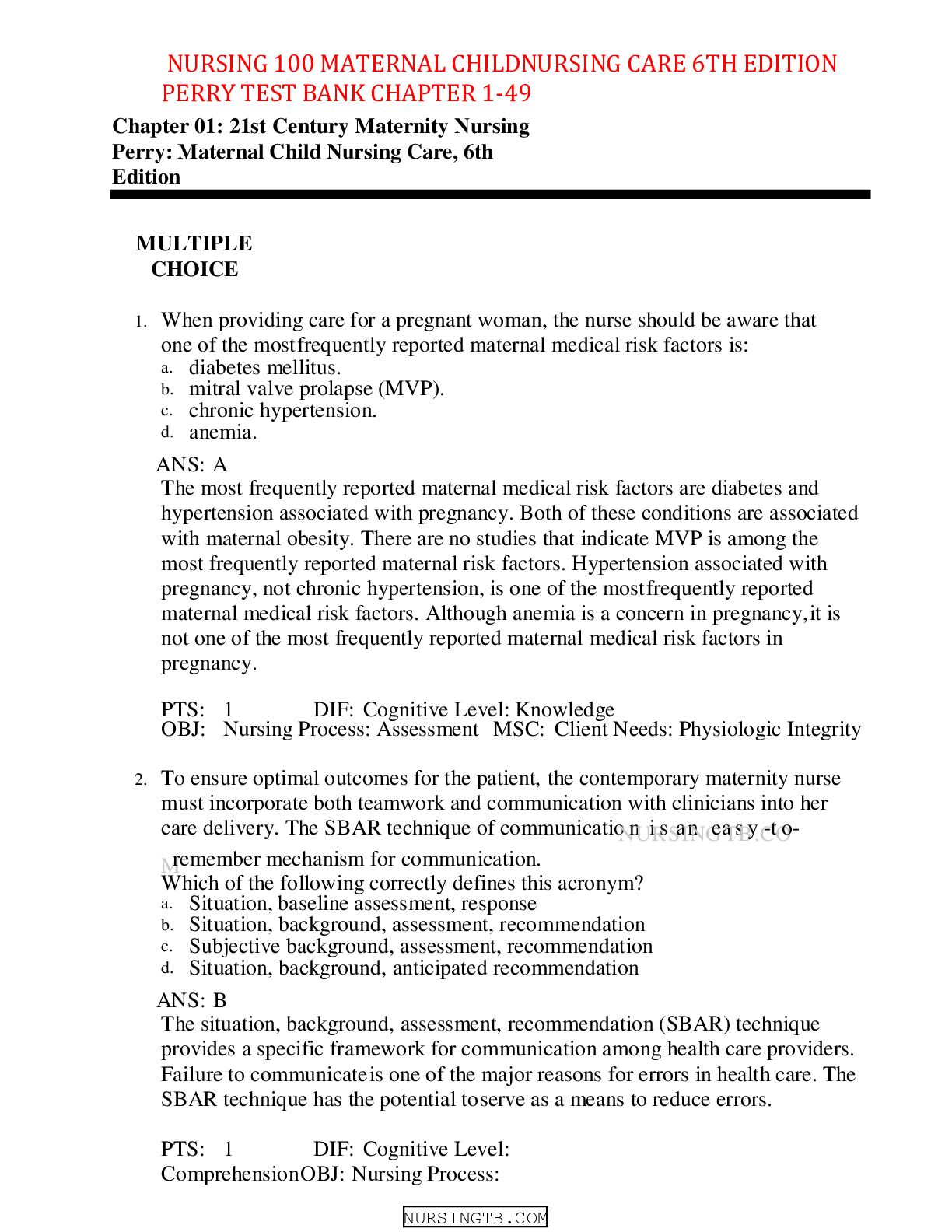

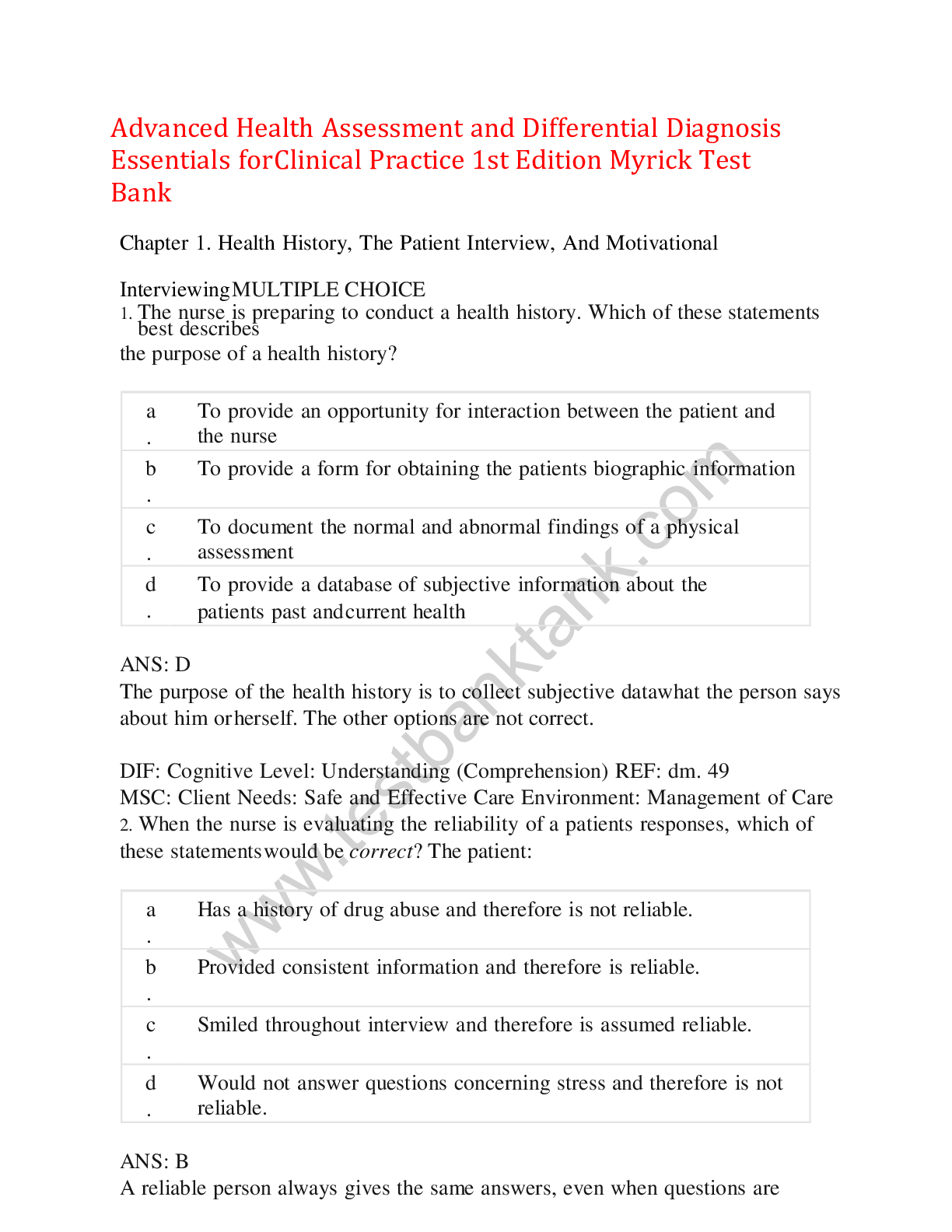
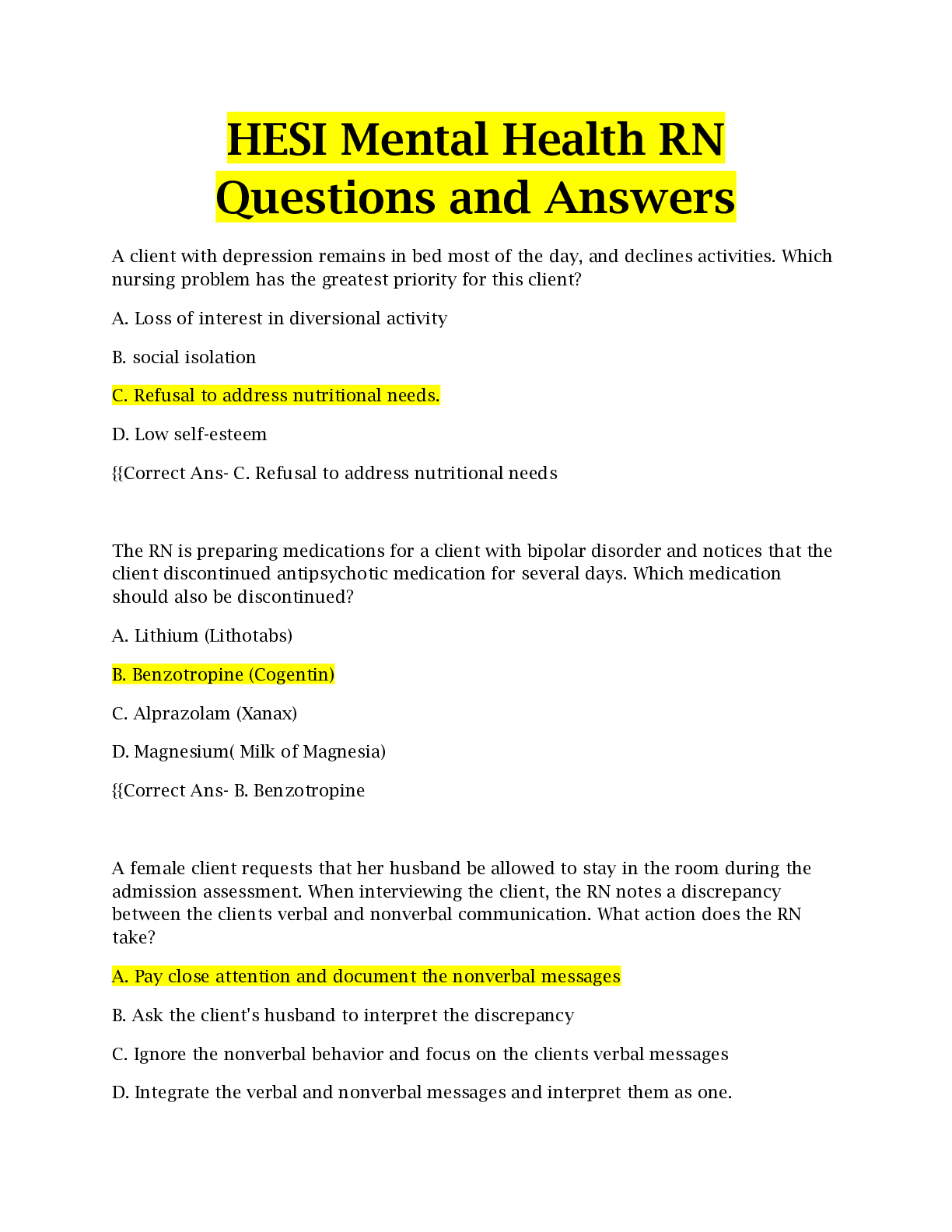
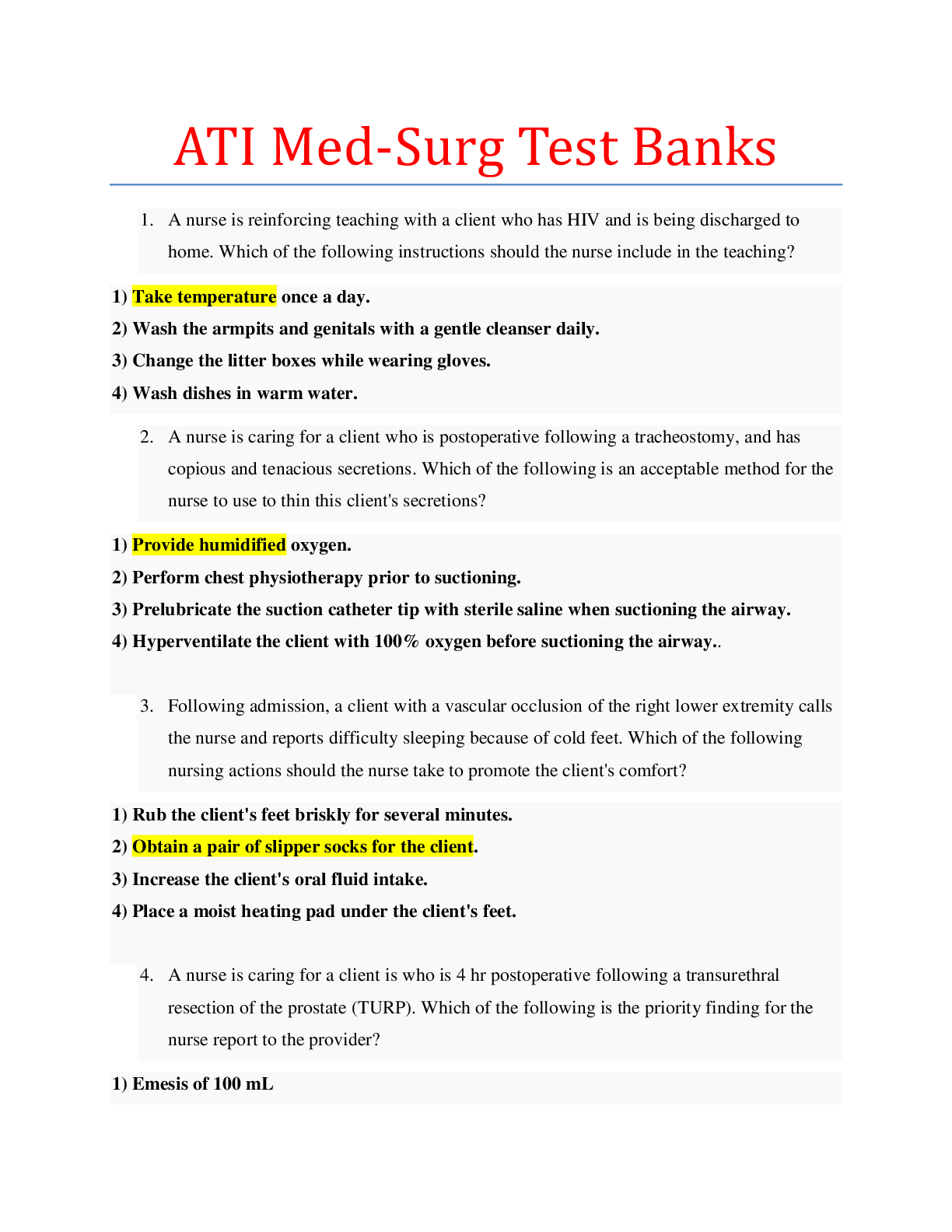


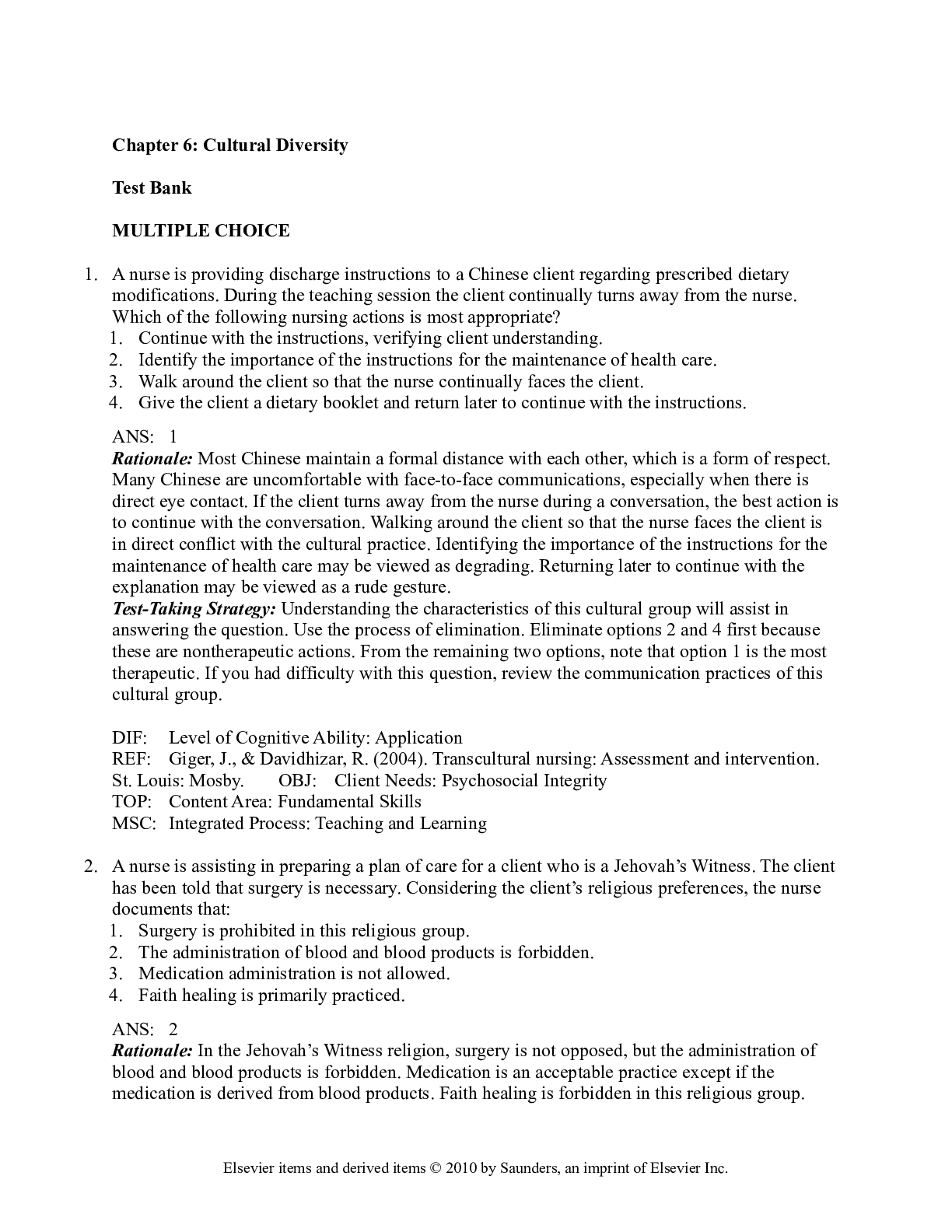
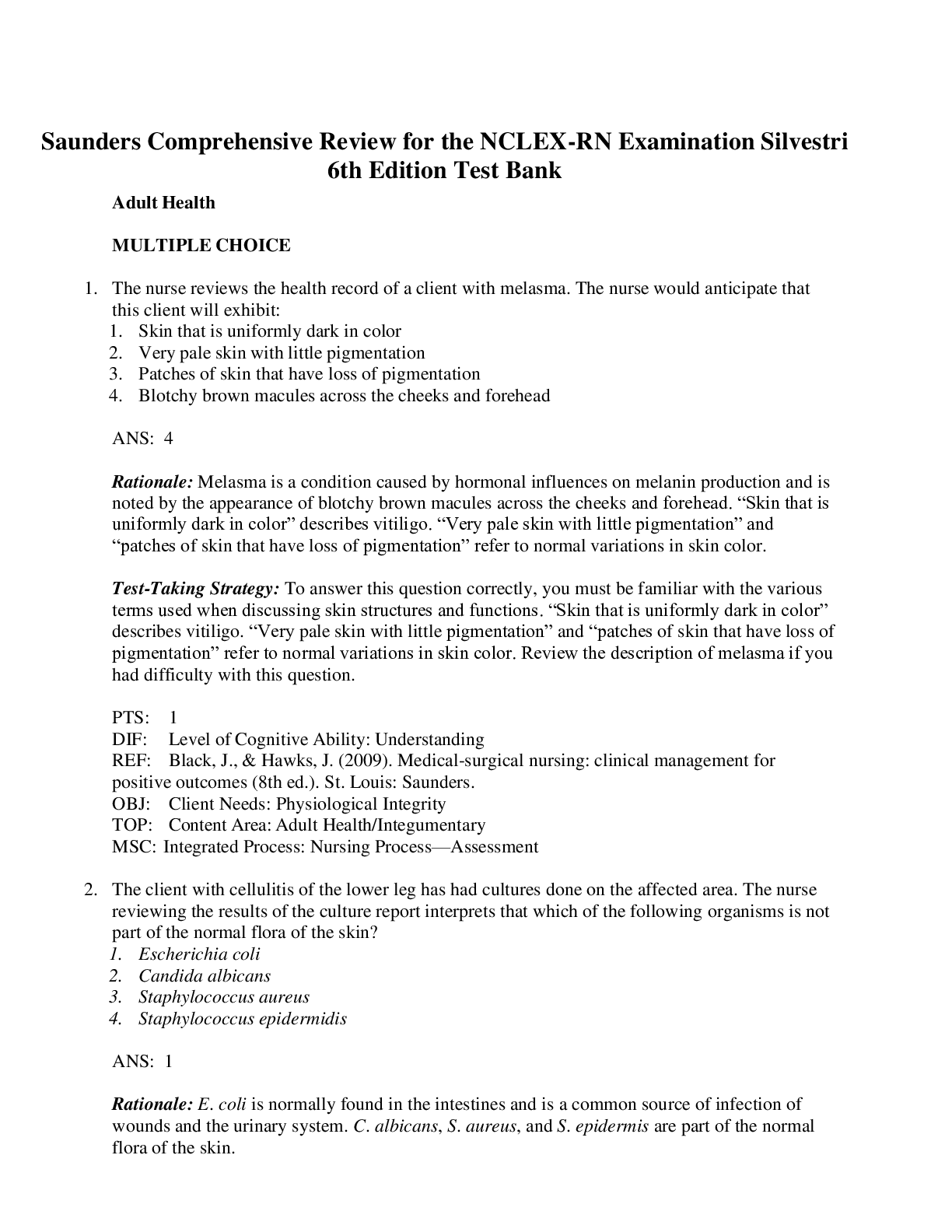
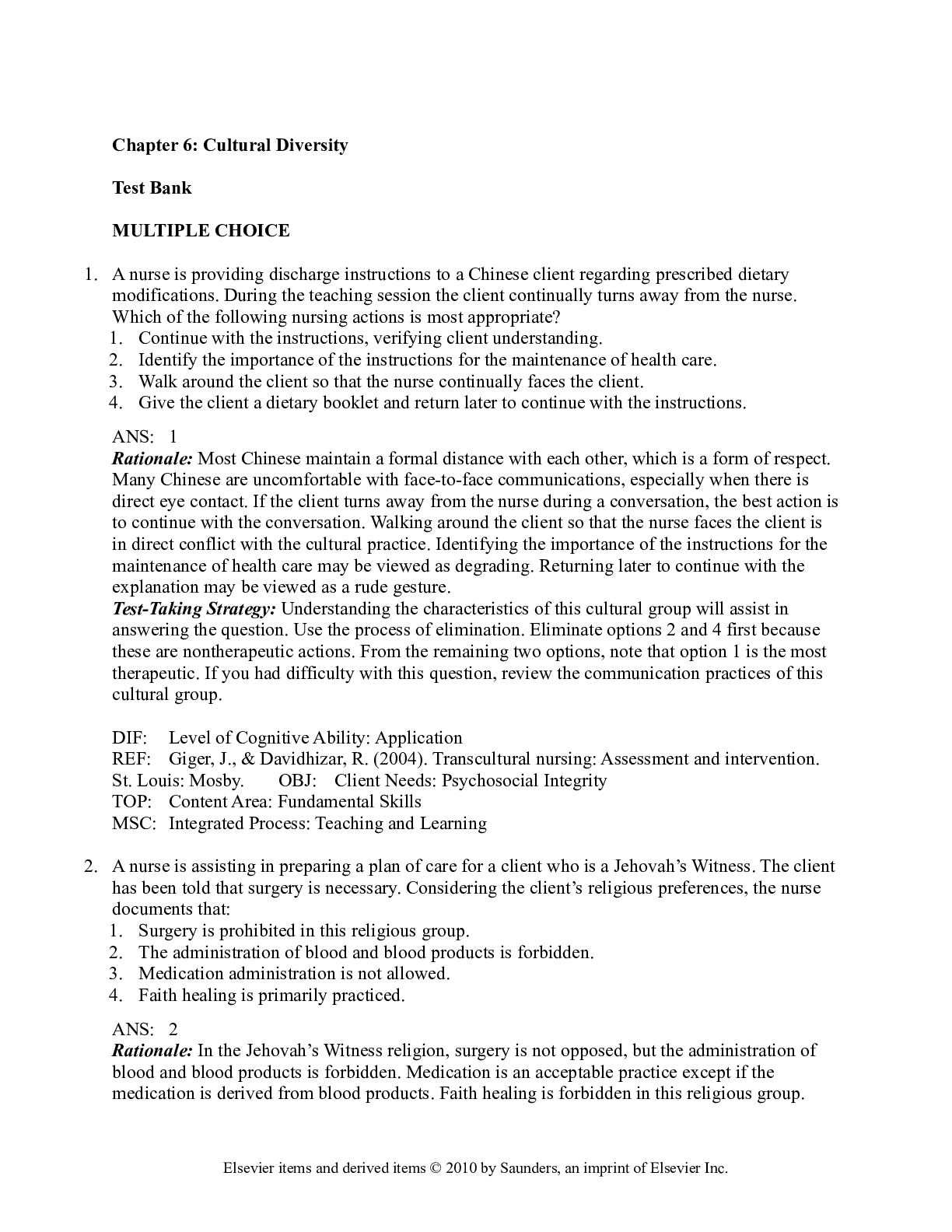

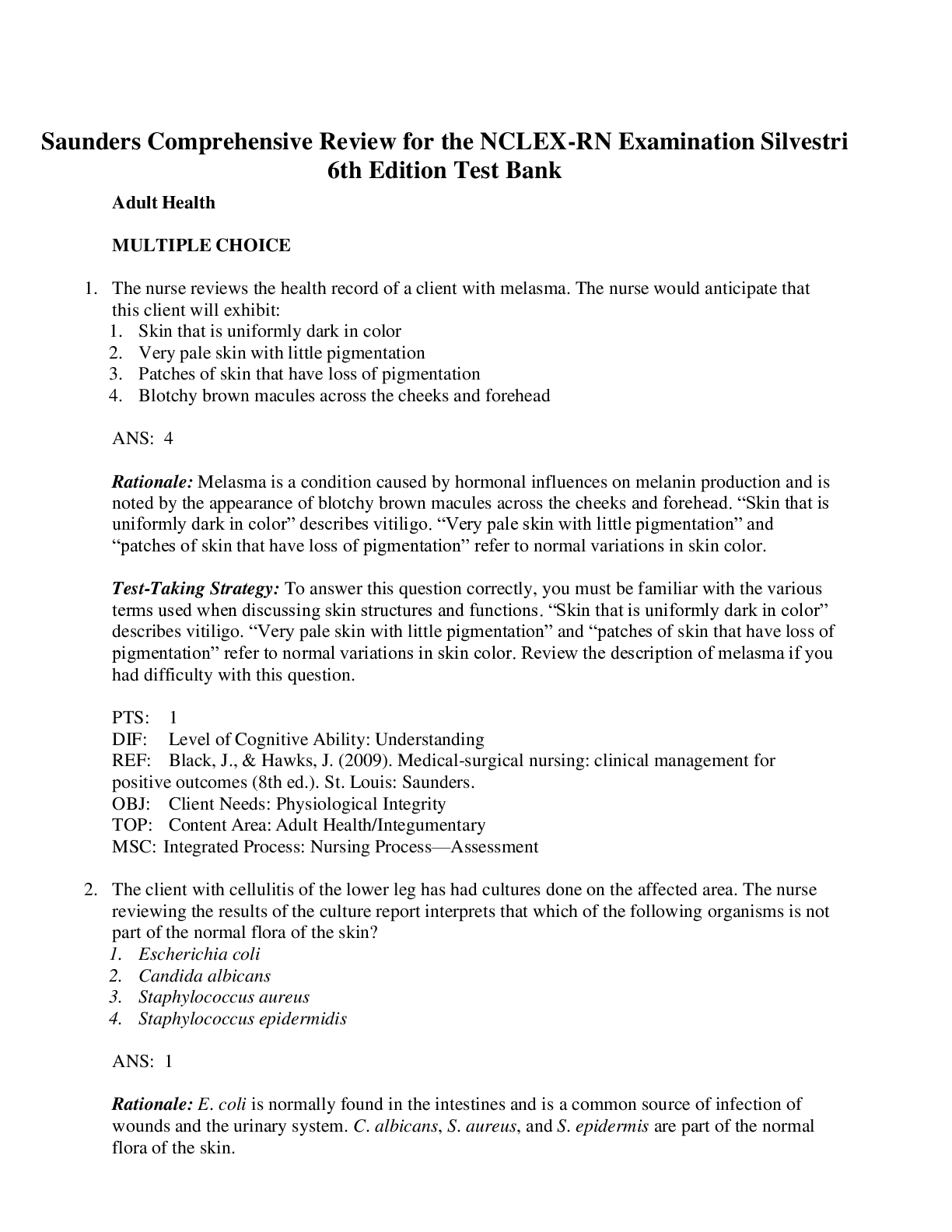
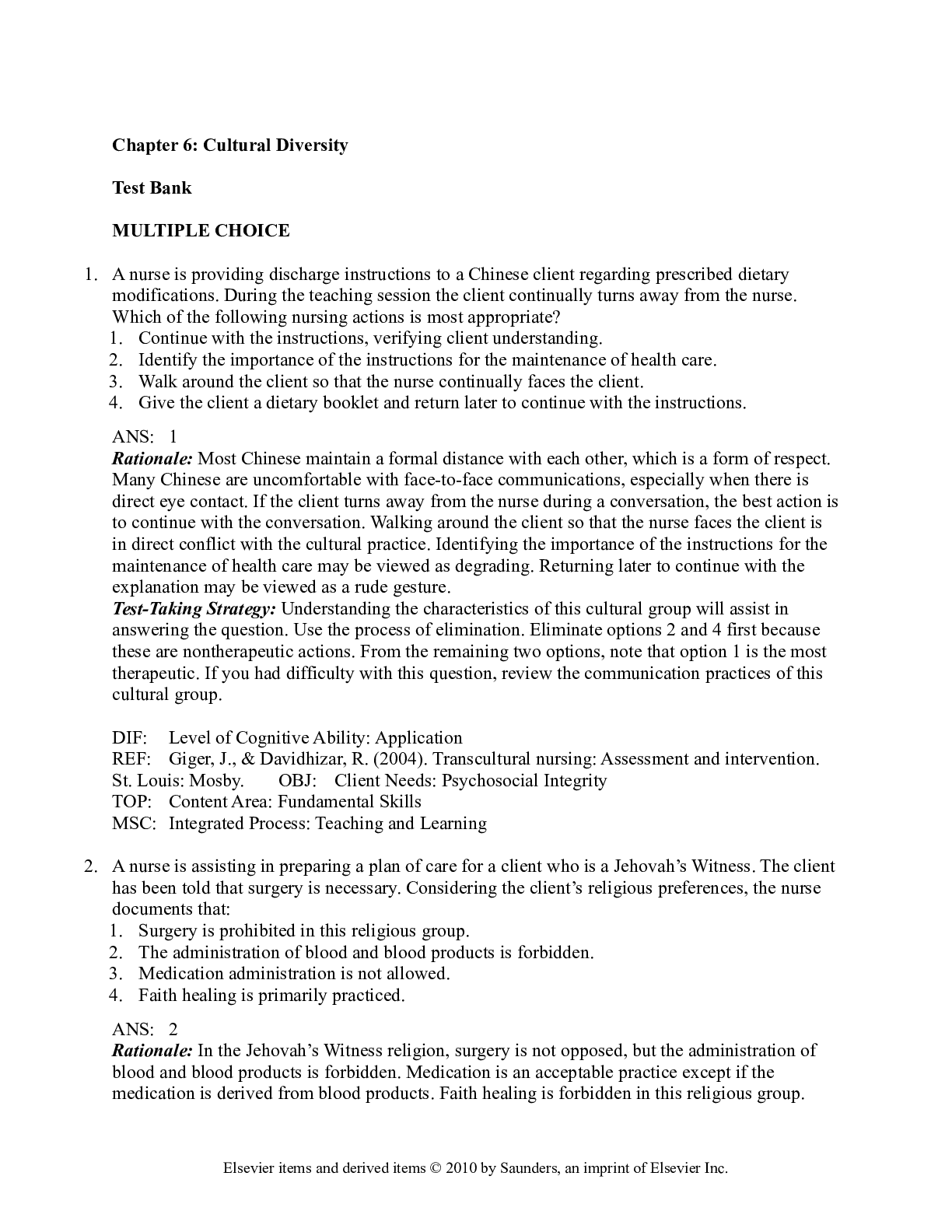
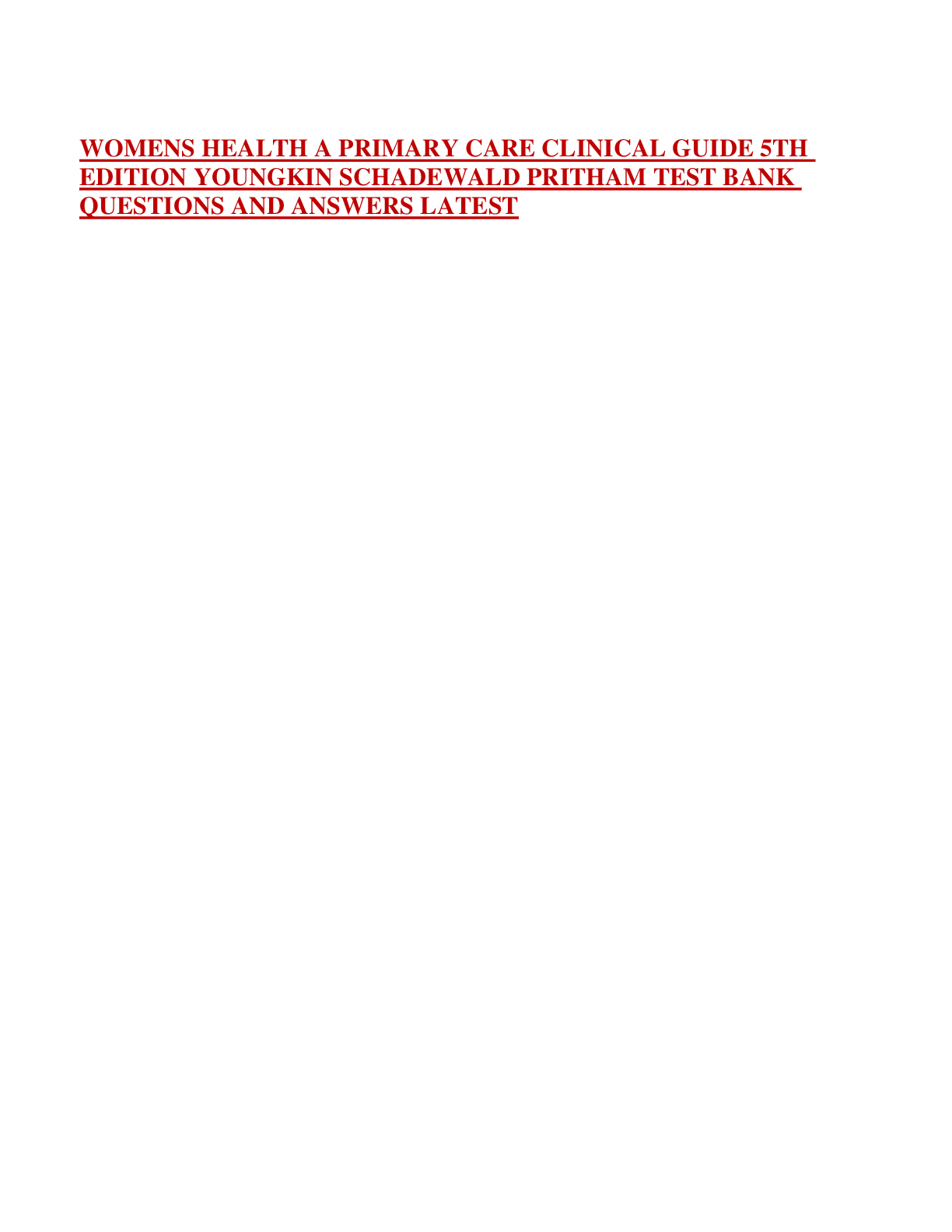

.png)
